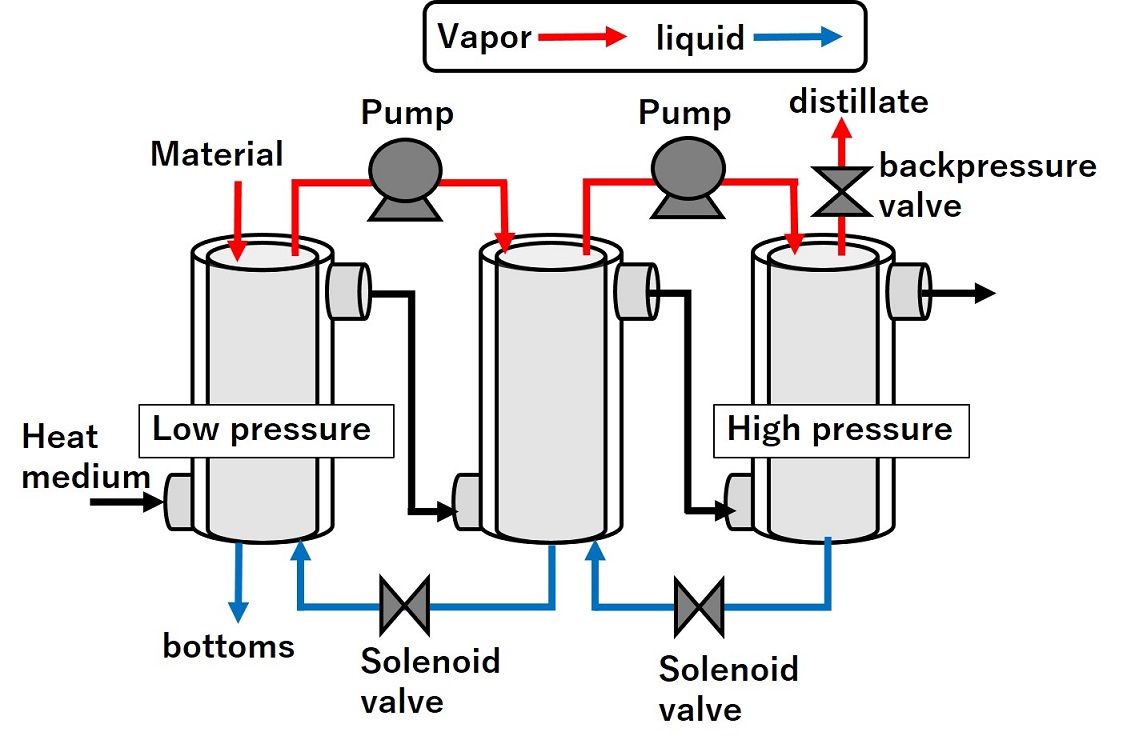
Nowadays, AI and IoT have become widespread, and demand for semiconductors has increased; therefore, reduction of costs and improvement of production efficiency are needed in producing a single crystal silicon ingot which is a key material of semiconductors. A 300 mm diameter single crystal silicon ingot is mainly produced by the Czochralski (CZ) method. To keep high product quality, the crystal radius and the crystal growth rate must be controlled precisely by manipulating the heater input, the crystal pulling rate, and the crucible rise rate. Expecting that model predictive control would be useful to realize precise control, we constructed the gray-box model of an industrial 300 mm CZ process in our past research. To predict the control variables using the gray-box model, it is necessary to calculate the initial values of the melt temperature and the heater temperature, which are not measured in the industrial CZ process. When the initial values were determined by minimizing the error of the controlled variables between the measured values and the calculated values using the gray-box model just before the prediction period, the prediction accuracy at the end of the pulling process was lower than the other period. In the present work, we proposed the method of estimating the initial values by the statistical model, which was built with the data of past batches. Moving window partial least squares was used to develop the statistical model since it can cope with the time-varying characteristics of the CZ process, which originate from changes in the crystal length and the crucible position. The prediction accuracy was validated using the data of two batches, and the results showed that the proposed method could reduce the prediction error on average by 24% in comparison with the conventional method of using only the data of the current batch.
Soft-sensors were commonly used by engineers to predict quality variables that can only be infrequently sampled using sensors readings that are continuously available. Soft-sensor models can be data-driven or model driven. Data-driven models using non-parametric models such as artificial neural network are simple to develop given sufficient data. However, there are usually concerns about the extrapolation ability of the model beyond the data range. Model-based soft-sensor usually requires a physical model and an observer algorithm such as Kalman filter to estimate hidden state variables that cannot be directly measured. However, the effort required to develop a physical model is usually quite cumbersome. The recent development of deep learning opens up the possibility of development of more complex data-driven models that may be able to capture the actual system dynamics. For example, recurrent neural networks can be cast into a sequence to sequence (Seq2Seq) conversation models that can predict subsequent conversions based on past speech. In this work, such a Seq2Seq model formulated into an observer-predictor model that allows identification of hidden states of the system based on past actions and outcomes, and predict future outcomes based on current and future actions. The model is applied to quality predictions during mode-transition for the Tennessee Eastman Process. We found that after learning a few mode-transition data, the model could predict mode-changes that have not been encountered. An industrial distillation column separating c4/c5 product was also studied. Results show that not only the model could successfully predict quality variables in the product stream, but also has much better gain consistency than a simple back-propagation network.
We propose an innovative monitoring method that can estimate the water content of granules by using only process parameters (PPs) obtained through standard instruments, e.g., thermometer and hygrometer. Thus, no investment is required to install specialized equipment such as a near-infrared (NIR) spectrometer, which is a common tool for process analytical technology (PAT). In addition, the proposed method is scale-free; the water content can be estimated with accuracy, regardless of the manufacturing scale, by selecting scale-independent PPs on the basis of variable importance in the projection (VIP) of partial least squares (PLS). The results of experiments have demonstrated the followings: 1) the prediction accuracy of the developed method is equivalent to a NIR spectra-based method commonly used in the pharmaceutical industry, 2) the developed method is robust against changes in manufacturing scale, and 3) the prediction accuracy of locally weighted partial least squares (LW-PLS), which can cope with both collinearity and nonlinearity, is significantly higher than that of PLS. The developed method is a powerful tool for scale-up study in batch processes because it enables scale-free monitoring for the water content of granules during fluid bed granulation at lower cost without additional investment. The developed method is expected to enhance the implementation of real-time monitoring of fluid bed granulation processes as a cost-effective alternative to the existing NIR method.
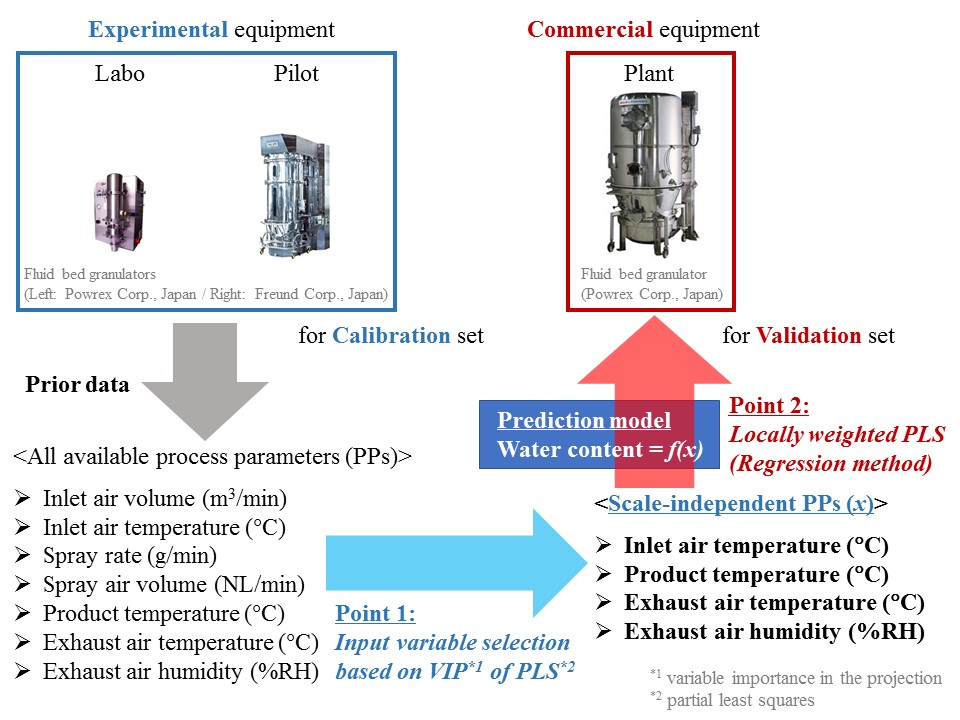
When designing a soft-sensor, we have to determine its parameters such as the number of latent variables of partial least squares (PLS) model. The parameters are usually selected to minimize the cross validation error, however, a soft-sensor model with one set of parameters should not cope with all the operation conditions. In such a case, the estimation error for some samples becomes large. In this research, to reduce the estimation error for those samples, the adaptive soft-sensor design method is proposed. In the proposed method, the leave-one-out cross validation error is calculated using the all the model construction samples. Then the samples with large estimation error are identified, and the model construction samples are divided into three groups. For each group, the parameters are optimized to minimize the leave-one-out cross validation error for the group. In addition, linear discriminant analysis (LDA) is conducted to find the discriminant axis in the input variable space. If the classification performance of LDA is not enough, kernel LDA is used. In online procedure, each of the model validation samples are classified into one of the three groups, and the parameters are adaptively selected. By using the selected parameters, the soft-sensor is developed and the output estimate is calculated. The usefulness of the proposed method was confirmed thorough its application to twelve industrial process data. The root mean square error (RMSE) was improved at most by 11.8%, and at least the same as the RMSE of conventional method using only one set of parameters.
Continuous manufacturing (CM) in the pharmaceutical industry has been paid attention to, because it is expected to reduce the costs of manufacturing. One of technical hurdles in continuous manufacturing is establishment and maintenance of predictive models for process monitoring. Conventionally, calibration models with optic spectra such as infrared or Raman spectra have been used as the predictive models for process monitoring. The calibrated models predict product qualities such as active pharmaceutical ingredient's content, moisture content, particle size, and so on. However, any changes in rots, ratio of ingredients, or operation conditions may affect the relationship between sensor information and the product qualities, which results in deterioration of predictive models. Operators must update calibration models to assure predictive accuracy; however, calibration always requires data acquisition. Thus, the use of calibration models intrinsically increases economical costs. To tackle this problem, the authors have been attempting to propose a calibration-free approach with infrared spectra, which employs an equation in physics. To apply the calibration-free approach to real processes, it is important that a model provides accurate and reliable prediction. In this study, we propose a method to improve predictive accuracy of a calibration-free approach after assessing predictive errors using a rational indicator. We verified that the update method succeeded in non-ideal binary mixtures.
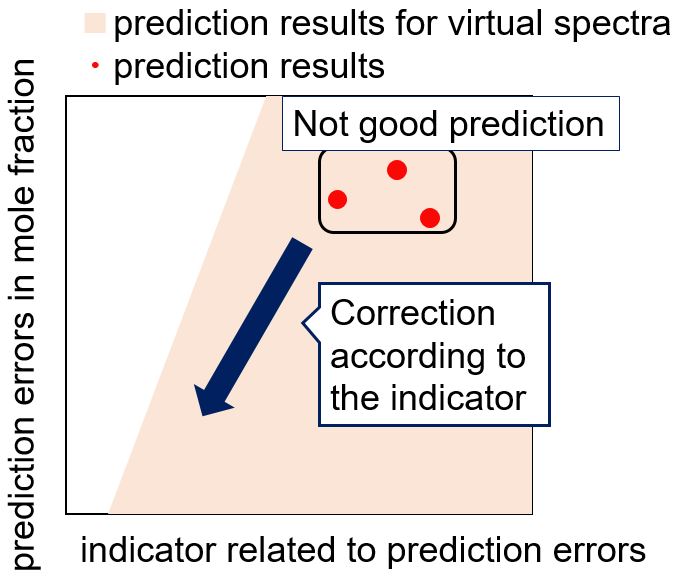
As the most important component of China's process industry, the refining and chemical industry is not only the pillar industry of economic and social development, but also an important cornerstone of the real economy. After decades of development, China's refining industry's production capacity has ranked second in the world, and has made great progress in product quality, cleanliness, supporting technology and process automation. With the rapid improvement of computer software and hardware, the development of machine-learning models and algorithm, the process industry has entered the era of big data. Also, with the impetus of the " Made in China 2025 " national strategy, intelligent refining related construction has been put on the agenda.
Modelling is the core of intelligent refining. The main feature of process industry contains high complexity, high dimensional and nonlinear characteristics, and so on. Centralized modeling will cause problems such as poor model performance. Therefore, system decomposition technology is built on model-based large-scale industrial process control strategies play an important role. EMD (Empirical Mode Decomposition) is an adaptive decomposition method proposed by Huang (1998) et al. for nonlinear processes. It has been effectively applied in different industrial fields and its effectiveness has been verified. CEEMD (Complete ensemble empirical mode decomposition) is an improved method of EMD. By adding two sets of white noise signals with opposite positive and negative, phenomenon of modal aliasing could be solved to some extent, and more multi-scale information in complex industrial processes can be better separate and identify.
CEEMD method is used to decompose the industrial FCC device in this work, and a soft sensor model is established at each sub-scale to capture more sub-scale information to achieve better overall measurement behavior. By comparing the results of decomposition modeling and centralized modeling, it can be found that the decomposition modeling method has advantages in measurement accuracy and better generalization performance.
Optimal control theory is applied to determine Pareto-optimal fronts for multi-objective optimization problems for seeded batch crystallization processes. A transformation of variables first suggested by Hofmann and Raisch (2010) is used to determine nearly-analytical expressions for the optimal supersaturation trajectory at each point on the Pareto front. A simple crystallization kinetic model for potassium nitrate crystallizing from water is used to illustrate the method.
Four sets of objective functions are considered in this work. Result show that if one objective is based on higher moments (e.g. the third moment of nucleated crystals) while the other is based on lower moments (e.g. the number mean crystal szie), the Pareto-optimal front is relatively wider, indicating significant competition between the two objectives. This is consistent with the conclusion of previous work (Tseng and Ward, 2017). In these cases, a constant growth rate trajectory may represent a good trade-off between two objectives. By contrast, if both objectives are based on higher or lower moments, the trade-off between the two objectives is less significant and the optimal trajectories for each single objective are similar.
This work demonstrates the inherent trade-off between objective functions in batch crystallization process and offers guidance for determining the “best” operating recipe when more than one objective is important. This understanding can facilitate the design of batch crystallization recipes.
References
Miller, S. M., Rawlings, J. B. (1994). Model identification and control strategies for batch cooling crystallizers. AIChE Journal, 40, 1312–1327.
Hofmann, S., Raisch, J. (2010). Application of optimal control theory to a batch crystallizer using orbital flatness, 16th Nordic Process Control Workshop, Lund, Sweden, 25–27 August 2010.
Tseng, Y. T., Ward, J. D. (2017). Comparison of objective functions for batch crystallization using a simple process model and Pontryagin's minimum principle. Computers & Chemical Engineering 99, 271-279.
Despite the fact that the modern chemical plants are becoming more complex than they used to be, their operating procedures are still synthesized manually. Since this practice is laborious and error prone, it is desirable to develop a viable approach to automatically conjecture a sequence of executable actions to perform various tasks in realistic processes (Li et al., 2014). In this work, the automata (Cassandras and Lafortune, 2008) are adopted to model all components in the given system. To facilitate efficient procedure synthesis, the entire operation is divided into distinguishable stages and the intrinsic natures of each stage, e.g., stable operation, condition adjustment, material charging and/or discharging, etc., are then identified. The control specifications of every stage are also described with automata to set the target state, to create distinct operation paths, to restrict operation steps to follow the preferred sequences and to avoid unsafe operations. A system model and the corresponding observable event traces (OETs) can then be produced by synchronizing all aforementioned automata. The corresponding operating procedures can be formally summarized with sequential function charts (SFCs) according to these OETs. ASPEN Plus Dynamic has been used to verify the correctness of these SFCs in simulation studies. Since more than one procedure may be generated, these simulation results can also be adopted to rank them based on operability, safety and other economic criteria. Three examples, i.e., a semi-batch reaction process and the startup operations of continuous flash and distillation processes, are reported to demonstrate the effectiveness of the proposed synthesis strategy in practical applications.
References:
Cassandras, C. G., Lafortune, S., Introduction to Discrete Event Systems, 2nd edition, Springer, New York, NY, USA, 2008..
Li, J. H., Chang, C. T., Jiang, D., Systematic generation of cyclic operating procedures based on timed automata. Chem. Eng. Res. Des. 92, 139 – 155, 2014.
Gaussian process regression (GPR) has been gaining popularity due to its nonparametric Bayesian form. However, the traditional GPR model is designed for continuous real-valued outputs with a Gaussian assumption, which does not hold in some engineering application studies. For example, causal analysis of defects in steel products is to discover the relationships between a set of process variables and the number of defects, which is the count data output; the Gaussian assumption is invalid and the GPR model cannot be directly applied. Generalized Gaussian process regression (GGPR) can overcome the drawbacks of the conventional GPR, and it allows the model outputs to be any member of the exponential family of distributions. Thus, GGPR is more flexible than GPR. However, since GGPR is a nonlinear kernel-based method, it is not readily accessible to understand the effect of each input feature on the model output. To tackle this issue, the sensitivity analysis of GGPR (SA-GGPR) is proposed in this work. SA-GGPR aims to identify factors that exert higher influence on the model output by utilizing the information from the partial derivative of the GGPR model output with respect to its inputs. The proposed method was applied to a nonlinear count data system. The application results demonstrated that the proposed method is superior to the PLS-Beta, PLS-VIP, and SA-GPR methods in identification accuracy.
Plant alarm system notifies an operator of plant state deviations. A poor alarm system might cause sequential alarms, which are triggered in succession by a single root cause in chemical plant. The sequential alarms reduce the capacity of operators to cope with plant abnormalities because critical alarms are buried under numerous unimportant alarms. In this paper, we propose an identification method of sequential alarms in time stamped alarm data. The time stamped alarm data, which is composed of the occurrence alarm tags and time, is generally logged in a plant operation data. Repeated alarm occurrence patterns in plant operation data can be regarded as sequential alarms. The proposed method formulates the problem of identifying sequential alarms in plant operation data as the problem of mining repeated similar alarm subsequences. The identified sequential alarms help engineers to decrease the number of unnecessary alarms more effectively. The usefulness of the method is proved by a case study of an azeotropic distillation column.
In biopharmaceutical drug product manufacturing, establishing and maintaining a sterile production environment after a product change-over is essential to guarantee the product quality. Inside an isolator, both machine exterior and interior surface require intensive cleaning/disinfection, achieved through hydrogen peroxide decontamination, and clean-in-place (CIP)/sterilization-in-place (SIP), respectively. Numerous sensors are available to constantly monitor the process and provide real-time measurements of process variables. Generally, the stored sensor data is only used for backtracking actions. In our work, we use this stored data sets for establishing a predictive monitoring system of the process and performing early failure detection. The first step includes data preparation and data classification to failed and successful runs. Followed by the boundary definition of successful runs, i.e., “Golden Zones” and the prediction of the complete process performance following a few minutes of operation. The prediction is achieved through the application of machine learning algorithms, such as Random Forest and k-Nearest Neighbor. The final step compares and assesses the distance of the prediction to the “Golden Zone” boundaries to guide the decision-making process by the operators. We further explore opportunities to improve the machine learning algorithms to achieve the earliest possible failure detection points, i.e. to maximize the “time distance to the alarm”. This could be especially helpful in the case where failures can be detected before the introduction of the hydrogen peroxide to avoid the need to repeat the aeration process which is the most time-consuming step in the procedure.
Our approach was applied to a hydrogen peroxide decontamination process of an industrial filling line resulting in a 50% reduction of the number of erroneous runs to be repeated leading to significant operational time and financial savings.
In process industries, fault detection and diagnosis (FDD) are the first and the most important steps of uncovering abnormal situations and conducting timely corrections. For decades, many FDD methods have been developed and they can be briefly categorized into data-driven and model-based approaches. Recently, combining different kinds of methods to create hybrid approaches that could overcome disadvantages of individual methods has become an attempting research topic. In previous work, we had already achieved better fault detection performance by combining data-driven method with process knowledge. In this work, we expand this idea to create a hybrid fault diagnosis approach, by combining the use of principle component analysis (PCA), qualitative reasoning, and process-knowledge. PCA is utilized as the detection tool in this approach. Meanwhile, qualitative reasoning is used for diagnosis because it has the ability to estimate process behavior with limited and uncertain information, mimicking fault reasoning activity of expert engineers. Process knowledge are important operating information, such as mass or energy balance, non-measured process parameters, and controlled/manipulated variable ratio in a control loop. In this approach, process knowledge is enhanced into both PCA fault detection and diagnostic qualitative reasoning as an effort to achieve better FDD performance.
This approach is tested on Tennessee Eastman Process. Before the test, target process is divided into several units of operation to construct qualitative unit model, and most importantly, to extract operating information using process knowledge. The equations describing these process knowledge are established both quantitatively and qualitatively. The quantitative equations are used for detection propose in the same way as our previous work. The qualitative knowledge equations, as well as qualitative unit models, are represented in consistency matrices for diagnosis propose. As a result of online sample testing, this approach achieved better fault diagnosis effectiveness in comparison with traditional PCA-contribution plot method.
This study investigated the fault diagnosis performance of the entire and early detections for complicated chemical processes using the time-series recurrent neural networks (RNNs). The investigation included various layers and neuron nodes in RNNs using lean and rich training datasets and compared these RNNs with the artificial neural networks (ANNs). Further, the mechanism of classification of the RNNs was revealed in this study. The benchmark of the Tennessee Eastman process was used to demonstrate the performance of the recurrent neural network-based fault diagnosis model. The results showed that the ANNs and the RNNs required only a single hidden layer to reach their maximum accuracy, regardless of whether they use lean or rich training datasets. It was also observed that the ANNs required a higher number of the nodes than the RNNs.
Furthermore, the accuracy of the RNNs using the lean training dataset was equivalent to that of the ANNs using the rich training dataset. The variant RNN can distinguish between the fault types using the rich training dataset. We discovered that the classification mechanism of the ANNs was a priori classification, which was incapable of separating the fault types having similar features. RNNs did not have this limitation, as they were not a priori classification. In summary, the RNNs demonstrated a better performance with regard to the fault diagnosis in chemical processes than the ANNs, and were effective in classifying the fault types with subtle features when there is sufficient data.
In order to mitigate the detrimental outcomes of process anomalies, modern chemical processes are generally equipped with safety interlocks. The conventional approach to design a protective system is usually aimed for prevention of the hazardous outcomes caused by a single abnormal event. However, since there may be more than one independent event producing multiple undesired effects within a realistic process, it is therefore necessary to develop a design methodology for the multi-input multi-output protective systems (see Figure 1). Specifically, the aim of this work is to construct a MINLP model to minimize the expected lifecycle loss of multi-event interlock and to generate the corresponding system configuration. In particular, the resulting specifications should include: (1) the number of online sensors in each alarm channel, (2) the voting-gate logic in each alarm channel, (3) the alarm logic, and (4) the number of shutdown elements for each shutdown operation. A simple example, i.e., the sump of a distillation column connected with a fired reboiler, is used in this paper to illustrate the aforementioned novel approach. From the optimization results, it can be observed that the proposed design strategy is indeed superior to the traditional one.
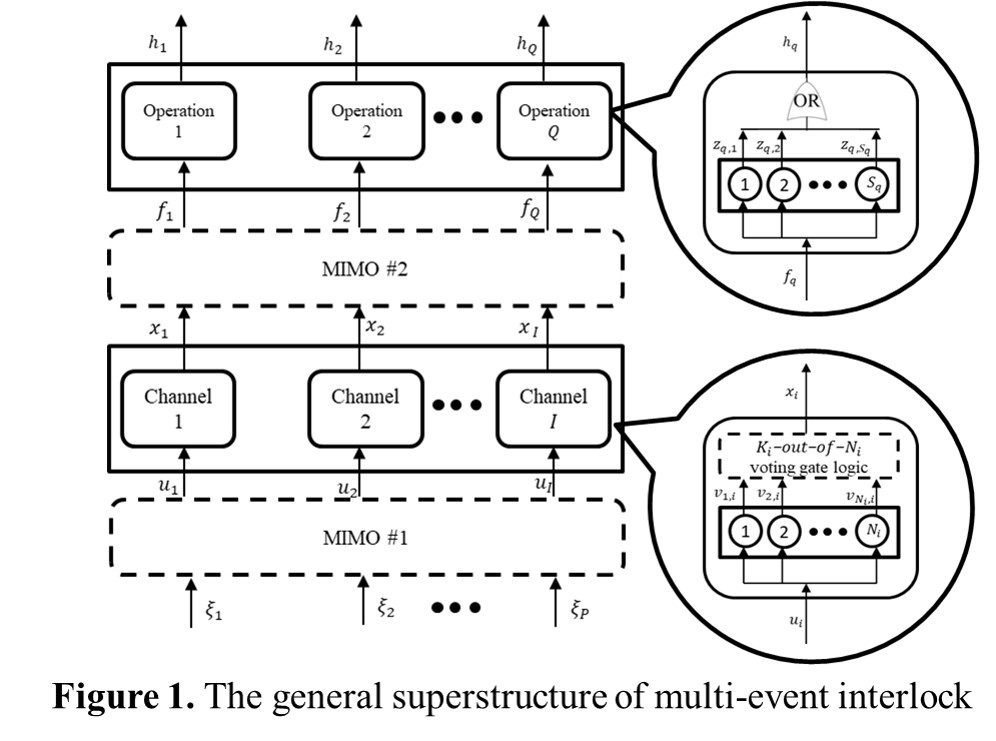
In recent years, cyberattacks against plant control systems can certainly be a growing threat. Conventional plant control system was closed system. However, it has been connected to external networks such as MES, ERP, and maintenance network. This change enables the various way of cyberattacks.
The cyberattacks against plant control system can directly harm physical space and cause accidents and disasters affecting human life.When the plant control system is under the cyberattacks, on-site plant operators should handle the situation suitably. However, plant operators are usually not aware of cybersecurity for plant operations. They don't have enough experiences and knowledges of cyberattacks.
What can they do under the cyberattacks? They must maintain safe operation and prevent the cyberattacks. The simple and effective way to prevent the cyberattacks is to cut off the attack path by disconnecting network cables.
Then it's important to minimize the negative impacts on plant operations such as safety, productivity and so on. For this purpose, if zoning and conduit of the network has been done in advance, operators can make a decision which zone should be cut off under the situation considering the network monitoring and impacts on plant operations.
To make a suitable decision requires enough useful information for plant operators.
In this paper, we developed a support tool for plant operator to make a decision against cyberattacks by combining two important information.
One is the vulnerability information of the components of the plant control system such as OS, middleware and applications of each OPC server, HMI, and so on. It is based on CVSS (Common Vulnerability Scoring System.)
The other is network monitoring information in the plant control network.
The developed GUI shows the options of the points to cutoff the network and supports plant operators to make a suitable decision against the cyberattacks.
In this study, a new methodology was developed to enhance the performance of control system in chemical process. An artificial neural network (ANN) was used to develop a model of the control system. For this, the process model was initially developed using Aspen HYSYS, and operation data was generated based on various operation scenarios. Then, the generated data was implemented to ANN for training, and results were tested and analyzed. Subsequently, the developed ANN model was integrated with an optimization algorithm so that manipulated variables were optimized in real time to maximize the operation efficiency. The developed model predictive control (MPC) system was tested based on various operation scenarios, and the results showed higher performance of the control system against conventional control methods.
Acknowledgment:
This work was supported by a research project entitled “Development of Integrated Interactive Model for Subsea and Topside System to Evaluate the Process Design of Offshore Platform” funded by the Ministry of Trade, Republic of Korea (Project no. N10060099).
Human interventions are common and indispensable during process operations. However, even in this era of big data where large volumes of process measurements are regularly collected and monitored, very little is known about human operators and their cognitive state while operating the plant. This absence of measurements prevents a scientific evaluation of the contribution of operators to the overall system performance. In this paper, we will discuss the need for an informatics-based approach to study the operational behaviors of plant personnel. Next, using the control room operator as an example, we will identify various technologies such as eye tracking and electroencephalography that can offer insights into the operators' cognitive state and their decision-making processes. Finally, we will explore the various ways by which such studies could help enhance the operator's performance – including context-aware interfaces, decision-support systems, and training protocols.
This paper provides a brief introduction to Reinforcement Learning (RL) technology, summarizes recent developments in this area, and discusses their potential implicationsfor the field of process systems engineering. This paper begins with a brief introduction to RL, a machine learning technology that allows an agent to learn, through trial and error, the best way to accomplish a task. We then highlight two new developments in RL that have led to the recent wave of applications and media interest. A comparison of the key features of RL vs. Model Predictive Control (MPC) and other traditional mathematical programming based methods is then presented in order to clarify their relative merits and shortcomings. This is followed by an assessment of areas that RL technology can potentially be used in process systems engineering applications. Particular focus is given on integrating planning and scheduling layers in multi-scale, multi-period, stochastic problems.
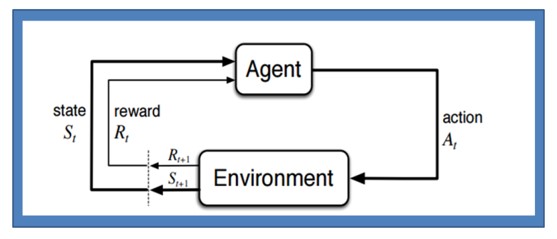
Gas hydrates are ice – like crystalline of natural gas and water. Several methods can be used to prevent hydrate formation such as solvent absorption, adsorption, and membrane process. This work studied modelling and optimization of natural gas dehydration using solvent absorption method. Triethylene glycol (TEG) was used as solvent to remove water from natural gas. Latin Hypercube sampling (LHS) was studied as sampling technique in term of its ability to represent the nonlinear model for optimization problem. The nonlinear model represents the relationship between the operating conditions and amount of produced dry natural gas. In the optimization, the total cost of the process was minimized. Both equipment and operating costs were considered in economic evaluation. The TEG absorption process was simulated using Aspen HYSYS version 8.8. The results show that LHS is able to accurately represent the nonlinear model between operating conditions and the total cost of the process for optimization problem. The optimal operating conditions of the process were obtained.
Model equations used in process design involve parameters, which can be estimated from experimental data. Estimating accuracy of model parameters is critical to ensure robustness of processes. The objective of this study is to quantify estimation accuracy using Bayesian inference techniques in parameter estimation. In this work, the Markov chain Monte Carlo (MCMC) method is used to obtain probability distribution. This algorithm repeats random sampling in parameter space and approximates the profile of posterior probability distributions by the density of sampled points. This method can handle complex nonlinear models. We demonstrate this method for estimating parameters in the Non-random two-liquid (NRTL) model for vapor-liquid equilibrium. The NRTL parameters are estimated by the MCMC method, and the influence of the number of experimental data on estimation accuracy is quantified. We compared two estimation cases, where 8 experimental data points and 13 experimental data points[1] are used, and the difference in the parameter accuracy is quantified. This estimation results for ethanol-water system are shown in Figure 1 for three parameters, a,b12, and b21 that describe intermolecular interactions in the NRTL model for the binary system. In addition, the proposed method is demonstrated for a multicomponent system that involve a larger number of components.
[1]Dortmund Data Bank Software & Separation Technology“VLE - Vapor Liquid Equilibria of Normal Boiling Substances”
http://www.ddbst.com/ddb-vle.html (2019.2.16)
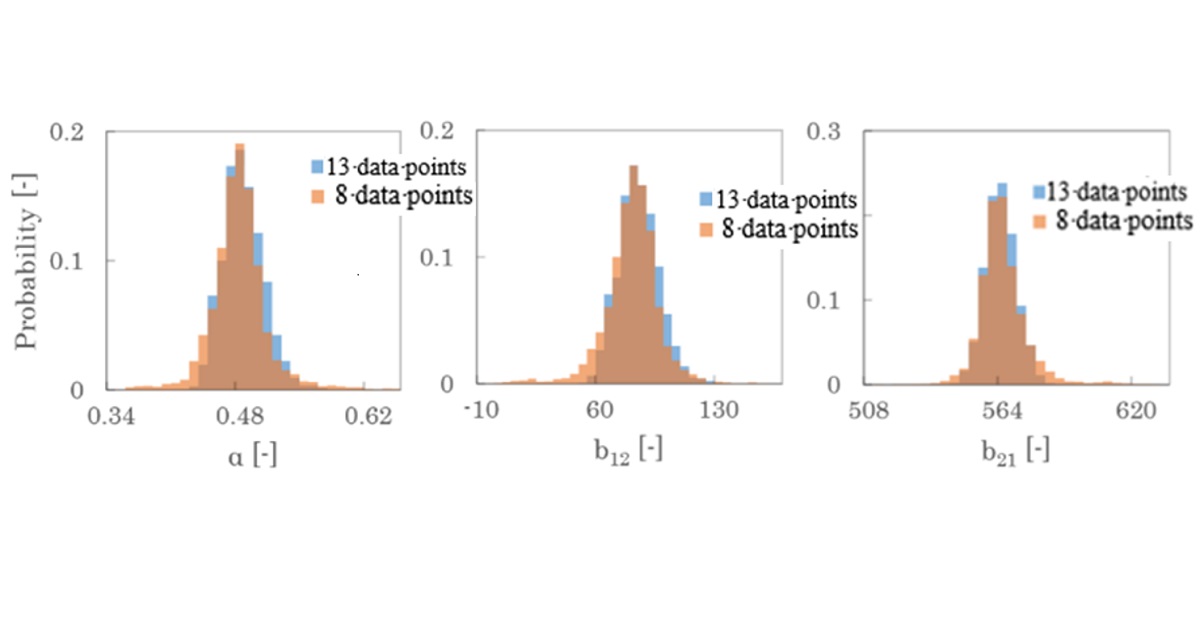
The growth in global economy has made water a limited resource in both quantity and quality. Freshwater resources available for our use are less than 1 % of the total water on the Earth. Reverse osmosis (RO) desalination technology became popular over the last decade due to its potential to produce freshwater from seawater. However, energy consumption in RO plants remain high and emission of concentrated brine from the plant has an impact on the environment.
This study aims to analyse the energy efficiency of various RO based desalination processes. Firstly, single-stage RO with pressure exchanger (PX) is analysed. Minimum normalized specific energy consumption (NSEC) is reduced from 5.00×105 J/m3 to 2.05×105 J/m3 by adding PX with 0.95 efficiency. Secondly, a simulation on multi-stage RO with PX is carried out. It is found that two-stage RO reduces minimum NSEC by 5.4 % compared with single-staged operation and increase recovery by 13.6 %. Even though multi-stage design may require higher capital cost and operating cost, optimised-stage RO design has certain advantages.
In the on-going research, membrane distillation (MD) and pressure-retarded osmosis (PRO) will be combined with multi-stage RO process to improve the overall energy efficiency. MD is a thermally driven membrane process that produces pure water, and PRO is an osmotically driven membrane process with external pressure, which is lower than the osmotic pressure difference, applied on the higher salinity solution side. The use of these processes are limited to when one has low-cost heat source, e.g. waste heat, and inexpensive lower salinity solution, e.g. wastewater. Since MD is less concentration-sensitive, it is expected to further concentrate the brine output, and highly concentrated brine is assumed to support PRO to generate greater energy and reduce minimum NSEC of the total process.
Heat ingress from atmosphere to LNG inside a tank due to temperature difference causes continuous evaporation of LNG that leads to increase of pressure and temperature. Therefore, it is necessary to continuously estimate the change in pressure and temperature inside the tank, using accurate numerical model in real time operation. For this, a new methodology was developed in this work to estimate total amounts of boiled off gas (BOG) and its composition and physical properties more accurately than conventional method, based on various operation conditions.
This work focuses on the efficient design with various heat integration methods and membrane arrangement for reactive distillation (RD) processes in order to enhance the energy saving. It is well-known that thermally-coupled, multi-effect, and external heat-integration approaches can reduce energy consumption in comparison with conventional distillation systems. Therefore, in this work, two processes will be discovered to demonstrate that hybrid configuration via various heat-integration and unit combination (such as pervaporation, PV) can provide further energy reduction compared to the conventional RD configuration. The first process is the diphenyl carbonate (DPC) production process that will be chosen to show a synergetic effect when thermally-coupling and external heat-integration arrangement are combined in the same reactive distillation sequence. The results show that in the DPC production process, the hybrid heat configuration can reduce energy consumption by 47% in comparison with the conventional RD configuration. On the other hand, another process is the ethyl levulinate (LAEE) production process that will be investigated to show a synergetic effect when thermal intensification is implemented in the hybrid RD-PV configuration in the LAEE production process. The hybrid heat-integrated configuration assisted with PV arrangement through excess ethanol (EtOH) design can save around 73% of energy consumption compared to the conventional LAEE RD configuration. Figure 1 shows the flowsheet of hybrid configurations for DPC and LAEE production processes, respectively. Finally, several control schemes of the DPC process would be investigated and tested the control performance based on this highly integrated configuration. Results show that the best control scheme has good disturbance rejection for throughput and feed composition disturbances.

For the chemical reactor systems using phase transfer catalyst (PTC), the third liquid phase that is insoluble in both aqueous solution and organic solvent is separated by regulating concentrations of salt and catalyst. Previously, our research group has demonstrated that application of alternate current (AC) voltage in formation of a layer of the third phase could increase a yield of the product for the phase-separable reactor using polyethylene glycol (PEG) as PTC. The AC application is considered to change the property of the third phase, which influences acceleration of mass transfer of product between two phases. In order to intensify the phase-separable reactor with third phase, it is necessary to optimize flow characteristics in the organic phase and the third phase to maximize the mass flux stably.
In the present study, influence of flow characteristics in the third liquid phase to dynamic behavior of batch-type phase-separable reactor is investigated for synthesis of phenyl benzoate by using PEG. Time variation of conversion of benzoyl chloride and apparent selectivity of benzoyl chloride to phenyl benzoate is analyzed by the rate based model. When experiments were carried out by using different types of impeller, higher value of the apparent selectivity was seen in a case of using the six-blade flat paddle impeller (6FPI). A clear characteristic of vertical circulation flow in the third phase was also observed by the flow visualization experiments, especially when 6FPI and two types of reverse pitched blade impeller were used. Hence, it is made clear experimentally and numerically that the vertical circulation flow in the third phase is an influencing factor to enhance the overall reaction efficiency and that it could be controlled by type of impeller, its rotational speed and concentration of potassium hydroxide for preparation of the third phase.
Pure, isomorphic, round, and free-flowing dimethyl fumarate granules in a size range of 250–2000 μm were successfully produced directly from esterification through the three-in-one intensified process of three distinctive steps of reaction, crystallization, and spherical agglomeration (SA) in a 0.5 L sized jacketed glass stirred tank. Dimethyl fumarate was prepared by sulfuric acid catalyzed esterification of fumaric acid with methanol. The reaction temperature was below the maximum allowable limit of 65 °C as determined by reaction kinetics to avoid the runaway situation. The dissolution rate of primary crystals of dimethyl fumarate was inversely proportional to the particle size which was strongly affected by the antisolvent addition and temperature cooling schemes during crystallization. However, the dissolution rate of the round granules was mainly dependent on the exterior dimension of the granules and not so much on the primary crystal size inside the granules. The mechanical properties such as density, porosity Carr's index, friability, and fracture force of round dimethyl fumarate granules generated in (1) three-in-one processes with the final temperatures at either 5 or 25 °C (Three-in-one I and II) and (2) SA of dimethyl fumarate, which was done separately and disconnected from the train of reaction and crystallization process at either 5 or 25 °C (SA I and II), were thoroughly studied and compared. The concept of scale-up for Three-in-one I and II was also verified in a 10 L sized jacketed glass stirred tank. Powder manufacturability such as flowability, blend uniformity, and compressibility had been substantially enhanced by spherical agglomeration. The added values of free-flowing and easy-to-pack properties to dimethyl fumarate in addition to its original intrinsic slip planes in the crystal lattice would make direct compaction into tablets feasible.
The Natuna gas field, located in the Natuna Sea, was discovered in 1973, is one of the largest natural gas reserves in Indonesia with estimated natural gas reserves of 222 TCF. However, until now, the use of Natuna gas is still hampered because of the very high CO2 content reaching 71%, while the methane content is around 28%. The dry reforming of methane (DRM) process is one of the potential ways to be applied in solving these problems to convert CH4 and CO2 become a synthesis gas containing CO and H2 as a raw material that can be applied to manufacture as intermediate products or end products in the petrochemical industry such as acetic acid.
The conversion of carbon dioxide and methane to acetic acid is carried out in three stages. In the first step, carbon dioxide and methane are reformed to produce the synthesis gas at temperature of 800 °C and pressure of 1 bar. In the second step, the synthesis gas is converted to produce methanol at temperature of 150 °C and high pressure of 50 bar. In the third step, the acetic acid is produced by reacting methanol and CO in the methanol carbonylation process. The modeling and simulation of the acetic acid production were conducted by using Aspen Hysys v.10, considering mass and heat balances. The cubic equation of state was applied for reforming and methanol processes. In order to produce 71 MTPD of the acetic acid, the feed flow rates of CH4 and CO2 are 190 MTPD and 520 MTPD, respectively. The total energy required is 46.3 MMBtu per ton of acetic acid. The acetic acid has a purity of 99.4% with a concentration of 500 ppm methanol, and moisture content of 5,700 ppm.
Keywords: Dry reforming of methane, Modelling, Simulation, Acetic Acid
The solid particles or liquid droplets entrained by multi-phase flow in process plants can cause erosion, which may result in leakage of piping system or equipment. Hence, it is essential to evaluate erosion rate for determining design margin and taking counter-measures. To date, many models have been proposed for prediction of erosion induced by particles and droplets, but there is large difference in their prediction accuracy. The present study aims to validate CFD-based prediction accuracy of major erosion models using the published experimental data, for engineering applications.
Among many erosion models proposed to predict particle-induced erosion rate, the models of Finnie, Tabakoff & Grant, E/CRC, Oka and DNV are usually applied for evaluating erosion. Experimental data in literature were used to investigate CFD prediction accuracy of the five erosion models. CFD simulations were conducted for different flow velocities and piping geometries containing elbows and reducer. CFD results show that Finnie model under-estimates the erosion rates significantly, and other four models over-predict the erosion rates for all the cases. Among them, the erosion rates predicted by Tabakoff & Grant model are closest to the experimental results with moderate and acceptable conservativeness. Therefore, Tabakoff & Grant model is applicable to predict particle-induced erosion rate in engineering applications.
Also, CFD simulations were performed to validate CFD prediction of liquid droplet induced erosion rate, using the data of water impingement experiments conducted by Isomoto et al.. The investigated erosion models include the models of Haugen, Isomoto and DNV. CFD results show that all the three models over-predict the erosion rates. Among them, the erosion rates predicted by Haugen model for all the water impingement velocities are closest to the experimental results with moderate and acceptable conservativeness. Hence, Haugen model is applicable to predict droplet-induced erosion rate in engineering applications.
Mathematical model is powerful conceptual framework to elucidate underlying biological mechanisms and guide further experiments. Researchers usually use equation – based model which is deterministic and assumes a homogeneous population, therefore, is not appropriate for systems characterized by a high degree of localization, distribution and dominated by discrete decisions. In this study, we developed a cell – based model that is more suitable for understanding the heterogeneity of stem cell population which is a challenge in bioprocessing for application in regenerative medicine.
Previously, different positions of region with cells deviated from the undifferentiated state of hiPSCs in cultures with SNL and MEF feeder cells were observed (Kim et al., 2014). In culture with SNL feeder cells, the deviation from the undifferentiated state occurred at the central region of the colony. In contrast, in culture with MEF feeder cells, the deviation from the undifferentiated state occurred at the peripheral region of the colony. Later, it was suggested that anomalous low and high migration rate at the central and peripheral region, respectively, led to deviation from the undifferentiated state in hiPSC colonies (Shuzui et al., 2019). Based on this hypothesis, we have developed a model in order to understand more deeply about these phenomena.
Our model described several cell behaviors including cell division, contact inhibition, cell migration, cell – cell interaction, cell – substrate interaction, and cell deviation. Using the model to understand the spatial heterogeneity of cell movement rate in colony, we explored that cell division was main factor that led to higher movement rate at the peripheral region than that at the central region of colony. The simulation results indicated that the model was able to reproduce the deviation from the undifferentiated state similar to the in vitro observation. The result also partially confirmed the in vitro hypothesis that stated anomalous cell migration triggered the deviation from the undifferentiated state.
The trade of LNG is usually regulated by contracts between suppliers and buyers which are generally 20-25 years long and provide security to buyers; however, their rigid take-or-pay clause transfers risk of surplus volume to the buyer. New suppliers have emerged due to liberalisation in local markets. The concomitant emergence of new small-scale customers has led to a competitive LNG market characterized by high demand variability. Consequently, there is an increased need felt by regasification terminals to purchase LNG through spot (i.e., short term) contracts. In this study, we seek to quantify the relative benefits of shifting from long term contracts to purchasing LNG on the spot market.
In this paper, we consider procurement of LNG by a buyer with its own demand variability and a set of producers each with its own selling cost. This collective demand may be met through either a long-term contract or through spot market purchase. Our goal is to identify critical conditions under which spot purchases are superior to long-term contracts and vice versa. Towards this, we develop MILP models to assess the minimal procurement cost i.e. sum of transportation cost and LNG price , taking into the account the dynamics of producers, shipping, and buyers. The set of producers is modelled with each producer having specific production profile along with storage tank and berth capacities and selling price associated with it. Similarly, a buyer is modelled with its varying demand over the planning horizon. The voyage of the LNG carrier is modelled as being dependent solely based on demand at consumption sites. Minimal procurement costs based on long term and short term contracts are calculated using these models and compared in this study. The results of the paper can be used to develop critical insights about the benefits of different LNG procurement contracts.
The nitrogen expander and single mixed refrigerant (SMR) liquefaction processes are recognized as the most favorable options to produce liquefied natural gas (LNG) at offshore sites. These processes have a simple and compact design that make them capital costs efficient. Nevertheless, huge operating costs, mainly due to the lower energy efficiency is an ongoing issue, so far. This lower energy efficiency is primarily due to the entropy generation that is dependent on the temperature gradients inside the main LNG cryogenic heat exchanger. The temperature gradients inside the cryogenic exchanger are strongly dependent on the refrigerant flow rates and pressures of refrigeration cycles. However, there are highly non-linear interactions between process decision variables and constrained overall energy consumption. Therefore, optimization of the LNG processes is still a challenging task in order to find optimal values of decision variables corresponding to minimize energy consumption. In this context, this study examines algorithm-specific parameter-less optimization methodology naming as “Jaya” to improve the energy efficiency of LNG processes for offshore applications. It was found that using the Jaya algorithm, the energy efficiency of SMR process and nitrogen dual expander liquefaction process can be enhanced up to 14.3% and 11.63%, respectively, as compared to their respective bases cases. This research was supported by the Basic Science Research Program Foundation of Korea (NRF) funded by the Ministry of Education (2018R1A2B6001566) and the Priority Research Centers Program through the National Research Foundation of Korea (NRF) funded by the Ministry of Education (2014R1A6A1031189).
Biopharmaceuticals are therapeutic drugs driven from biological means such as monoclonal antibodies, engineered protein hormones, cytokines and vaccines. As the biopharmaceutical sector has matured, pressure is increasing for design of flexible process configurations that can cope up process variability associated with the manufacturing of biopharmaceuticals. Due to biological nature of the reactants, it is challenging to maintain required purity of final product and other quality control measures. Under the risk of high clinical failure linked to drug development coupled with greater process variability, design of decision support system for multi-product facilities in biopharma remains a challenge. A lot of work has been done towards planning, scheduling and optimization in process system engineering (PSE), and recently increasing efforts are being made to understand process design and optimization in biopharmaceutical industry. Therefore, the purpose of present study is to conduct research and develop novel models to fill the gap between computer aided process design tools and mathematical optimization and scheduling. In the present work an attempt is made to compare process scheduling using mathematical programming versus conventional software tools such as SchedulePro®[1] to explore techno-economic benefits, if any. An example adopted from SchedulePro® library, on a microbial biopharmaceutical process, has been modelled and validated using mathematical programming based approaches [2]. The Gantt chart is given in Fig.1. Another case study from a process for Lethal Toxin Neutralizing Factor (LTNF) production from E.coli, for the treatment of snakebite, has also been considered for validation of the proposed model.
References
[1] SchedulePro® software, Intelligen, Inc., USA: http://intelligen.com/schedulepro_overview.html
[2] M.A. Shaik; A. Dhakre; N. Patil; A.S. Rathore, Capacity optimization and scheduling of a multiproduct manufacturing facility for biotech. therapeutic products, Biotechnol. Prog., vol. 30, no. 5, pp. 1221-1230, 2014.
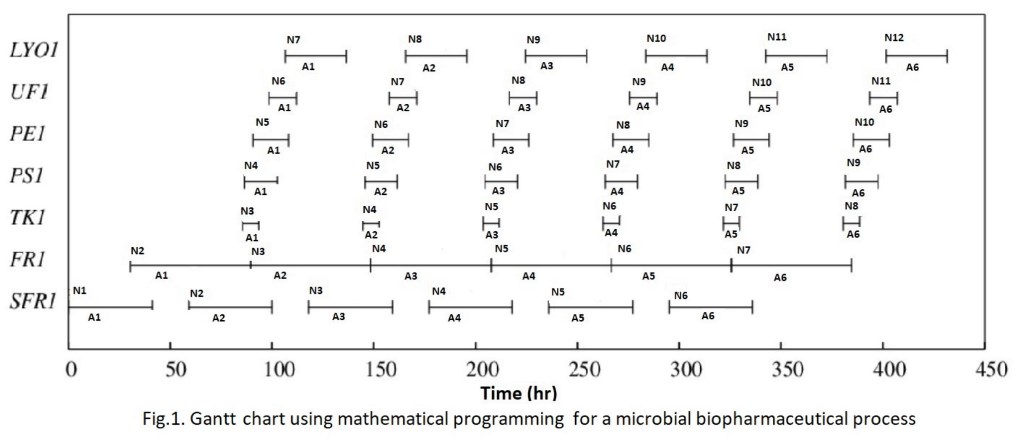
Recently, lignocellulosic biomass have emerged as a renewable energy source due to reduce environmental pollution with carbon-neutral fuel. However the storage problem due to weak water-resistance and which has a disadvantage of low heating value compared to fossil fuels. In order to overcome this problem pretreatment process (crushing, crushing, compression molding, carbonization, torrefaction) are required and in this study torrefaction was selected. Removal of moisture content through the torrefaction process increases energy per unit weight, which has advantages for storage, transportation and finally improves fuel properties. But if the process time was too short, heating value can't be increased, on the other hands, the useful heating value can be decreased caused by long processing time. So proper conditions were needed. In this study, the development of heat value one-dimensional prediction model for optimization of the torrefaction process was performed. A comparative analysis was conducted with the results of torrefaction experiments (200, 230, 270 °C, 20, 30, 40 min). Steuer's heating value estimation equation (r2 = 0.937, RMSE = 11.664) was selected as the most suitable empirical formula. Finally, derive the optimal torrefaction condition, according to the process conditions through case study.
Fluid catalytic cracking (FCC) is one of the most critical thermal conversion processes in refineries, and the modeling of FCC process is a useful tool to investigate, simulate, and optimize this complex industrial process. The selection of key variables in FCC process modeling mainly relies on the design handbooks or operating experience. However, the causal relationship between modeling variables and target variables may vary over time owing to the changing operating conditions, flexible feedstocks and some other issues occurred under uncertainty. It is essential to analyze the key variables that have an impact on the target variable in real time. A filter-wrapper hybrid feature selection strategy is proposed in our work to find out the key variables in an FCC process with respect to certain target variables. In the filter stage, the irrelevant variables are screened out by the ReliefF algorithm from the dataset that contains 445 candidate variables. Next, in the wrapper stage, the genetic algorithm (GA) is used to generate a large number of subsets, and the support vector regression (SVR) is carried out to test the performance of different subsets with the multi-objective considering both the prediction error and the magnitude of the subset. For the demonstration purpose, the process variable like the pressure of reactor and product indices like gasoline yield, diesel yield are chosen as the targets. The results indicate that the hybrid strategy can reduce the magnitude of subset over 92% within 30 mins by which it suggests the potential for implementation in industrial scenarios.
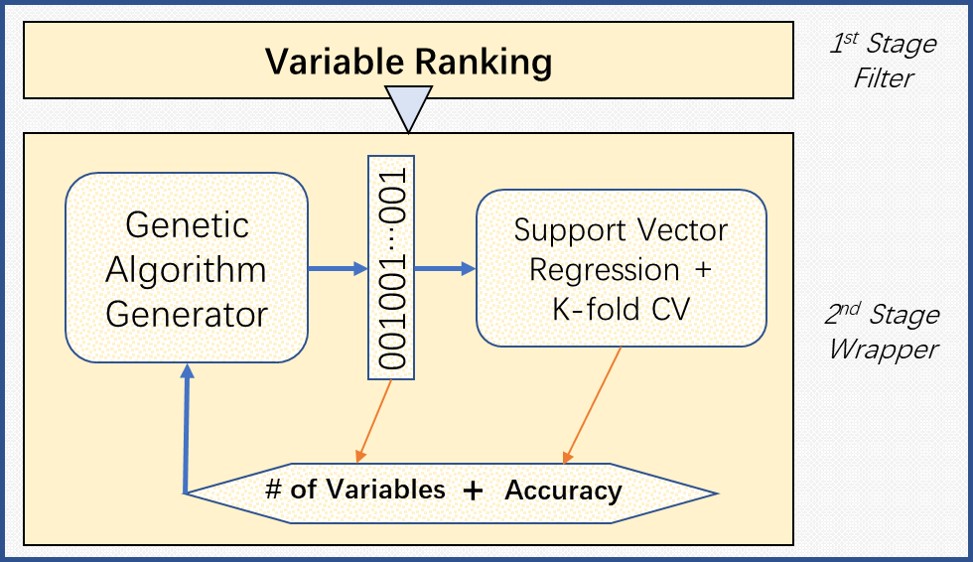
Salts are generally prepared by acid–base reaction in relatively large volumes of organic solvents, followed by crystallization. In this study, the potential for preparing a pharmaceutical salt between haloperidol and maleic acid by a novel solvent-free method using a twin-screw melt extruder was investigated. The pH–solubility relationship between haloperidol and maleic acid in aqueous medium was first determined, which demonstrated that 1:1 salt formation between them was feasible(pHmax 4.8; salt solubility 4.7 mg/mL). Extrusion of a 1:1 mixture of haloperidol and maleic acid at the extruder barrel temperature of 60 °C resulted in the formation of a highly crystalline salt. The effects of operating temperature and screw configuration on salt formation were also investigated, and those two were identified as key processing parameters. Salts were also prepared by solution crystallization from ethyl acetate, liquid-assisted grinding, and heat-assisted grinding and compared with those obtained by melt extrusion by using DSC, PXRD, TGA, and optical microscopy. While similar salts were obtained by all methods, both melt extrusion and solution crystallization yielded highly crystalline materials with identical enthalpies of melting. During the pH-solubility study, a salt hydrate form was also identified, which, upon heating, converted to anhydrate similar to that obtained by other methods. There were previous reports of the formation of cocrystals, but not salts, by melt extrusion. 1H NMR and single-crystal X-ray diffraction confirmed that a salt was indeed formed in the present study. The haloperidol–maleic acid salt obtained was nonhygroscopic in the moisture sorption study and converted to the hydrate form only upon mixing with water. Thus, we are reporting for the first time a relatively simple and solvent-free twin-screw melt extrusion method for the preparation of a pharmaceutical salt that provides material comparable to that obtained by solution crystallization and is amenable to continuous manufacturing and easy scale up.
The United Nation 2030 Agenda for Sustainable Development has dedicated Goal 6 (Clean Water and Sanitation) for better water management, with 8 targets and 11 indicators identified for progress monitoring. Some of the common strategies to achieve better water management include the “4Rs” techniques – reduction of pollution at source, removal of contaminant from wastewater, reuse of wastewater, and recovery of by-products. Within the process system engineering community, some systematic techniques have been developed since the past 3 decades, aiming to design sustainable chemical processes. One of the most promising techniques is arguably process integration, with pinch analysis and mathematical programming tools developed specifically to handle water management issues. However, most developed techniques were meant for water network systems at steady state condition, i.e. without changes in process condition. This paper presents a new design methodology based on a recent developed corner point method, for the synthesis of flexible water networks system. In this case, the flowrate and purity of water sources and sinks may change periodically over time. Hence, the synthesised water network should be able to absorb the changes of sources and requirements of sinks. Literature example is used to illustrate the proposed methodology.
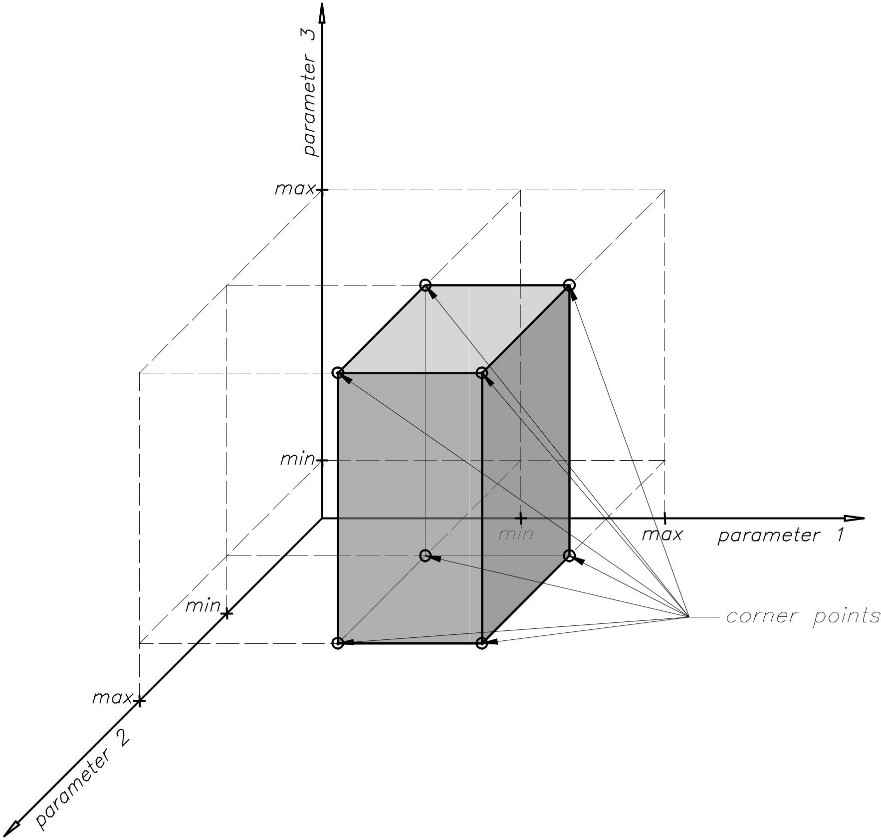
Monoclonal antibodies (mAbs) are an important fraction of the growing biopharmaceutical market. The rapidly expanding demand for mAbs is making it necessary to optimize the production processes to reduce manufacturing costs and time. Generally, production in continuous mode can improve process efficiency. Continuous manufacturing has been previously studied for individual process units in the upstream, e.g., perfusion cultivation, and downstream, e.g., chromatography separation using simulated moving bed. Integrated continuous production modes have been demonstrated experimentally, and stability in end-to-end operation have been presented. This work aims to explore the available design options and map favorable production modes at different production scales and sizes. The work also aims to explore the impacts of recent developments in cell design and advancement of cell tolerance on the process performance and resulting favorable operating modes.
Production data has been obtained from a pilot scale research facility for the production of mAbs from Chinese hamster ovary (CHO) cells. Different models for the large-scale cultivation and chromatography separation have been fitted against the production data, and the appropriate models were selected. After confirming the model performance using the production data, we performed economic process assessment. Different scenarios were considered regarding operation modes, i.e., batch or continuous, and equipment, i.e., single-use or multi-use, for the individual units as well as the end-to-end process.
The simulation results indicated that the favorable scenarios varied in the upstream and downstream depending on the production scale and the CHO cell performance. The superiority of the fully integrated continuous process has been seen regarding productivity. Sensitivity analysis revealed the relevance of the cell performance. This finding will open up a new research opportunity for PSE to tackle simultaneous design of cells, products, and processes.
It is very important to consider all the units and operating parameters of the individual units in the gas-oil-separation-plant (GOSP) optimization. However, the differences in the governing principle of these units make it extremely difficult to optimize the GOSP operation. Also in real operation, optimum parameters for the individual units are difficult to implement and establishing the optimum control condition for the individual unit will be difficult to achieve as all the units are interlinked to each other.
The current practice is to set the parameters determined at the design stage by simple laboratory test without accounting for the changes in temperature (fixed ambient temperature) and pressure on the crude oil properties as reservoir pressure. This results in loss of the quantity of the crude oil at the stock-tank causing a loss in the profitability of the plant.
The objective of this project is to develop a generic integrated framework for maximizing the oil recovery by optimizing the gas-oil-separation-plant (GOSP) parameters. A typical Saudi Aramco GOSP plant consists of multi-stage separators, heater-treater, and stabilization units along with the stock tank to mimic the oil train. Amongst the various parameters, only the controllable parameters such as pressure, and temperature were considered as optimization parameters to achieve the maximum oil recovery.
The GOSP plant model was developed using “Omegaland” software. To evaluate the effect of the various parameters many runs were initiated for generating the data. Based on the generated data a model was developed using artificial intelligence techniques. The model served as a tool for optimizing the controllable parameter to maximize the oil recovery which is the ultimate goal of the GOSP.
The generic integrated framework model serves as a guide to determine the optimum operating condition for maximizing the oil recovery resulting a significant monetary gain by improving GOSPs efficiency.
Carbon Capture and Storage (CCS) is one of the options for mitigating global warming by reducing carbon dioxide emissions, which involves source separation of CO2 from gaseous effluent streams, transportation of CO2 through suitable storage, and storing the same underground or geological reservoirs for a permanent period. Since CCS is a resource intensive process with multiple uncertainties, it must be modeled and validated under several circumstances for practical use. This study focuses on worst-case analysis based on continuous-time formulation for CCS systems under uncertainty. In the model, end time of operating life of CO2 sources, maximum storage capacity for different sinks, and compensatory power carbon footprint are considered as uncertain parameters. Recent work of Shaik and Kumar [1] has been extended to consider these uncertainties in the model. Two case studies are solved to validate the model over different time periods (40 yr and 50 yr). Similar to He et al. [2] the revised model [1] is also solved for different risk levels (α= 0 and α= 1) which demonstrates the modification and simplification of the model [1] compared to He et al. [2]. As shown in Table 1, the same optimal solutions are obtained compared to the literature for the minimum and maximum amounts of total CO2 captured. When compared to the worst-case solutions, the nominal solutions (without uncertainty) pertain to higher risk or perhaps infeasible zones.
References
[1] M. A. Shaik; A. Kumar, Simplified model for source–sink matching in carbon capture and storage systems, Ind. Eng. Chem. Res., vol. 57, no. 9, pp. 3441–3442, 2018.
[2] Y.-J. He; Y. Zhang; Z.-F. Ma; N. V. Sahinidis; R. R. Tan; D. C. Y. Foo, Optimal source–sink matching in carbon capture and storage systems under uncertainty, Ind. Eng. Chem. Res., vol. 53, no. 2, pp. 778–785, 2014.
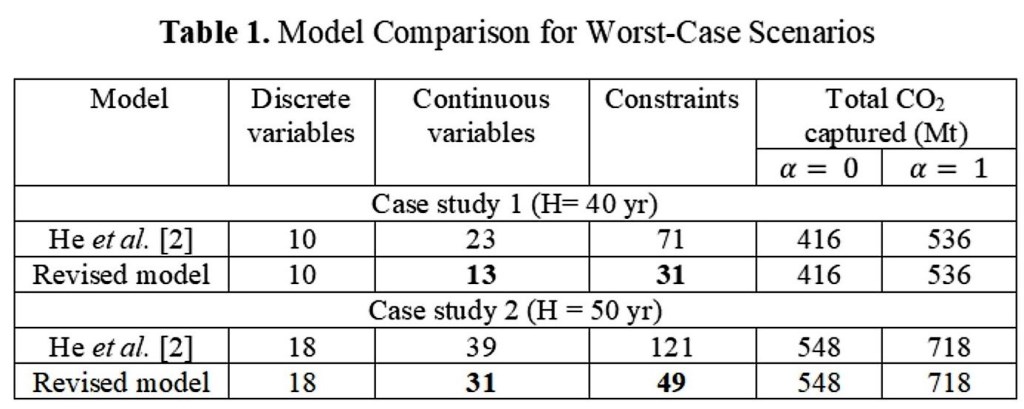
The grand challenges facing human societies are all closely interconnected with the sustainable provision and consumption of energy, water and material resources for constantly growing and developing populations, as well as the subsequent processing and management of wastes and pollutions. In this work, a series of decision-support platforms are developed combining comprehensive database, agent-based simulation and resource technology network optimization, to deal with the challenges of energy, water, food, and waste systems through a nexus manner for a circular economy. As key components of smart city development strategies, the data-driven systematic tools and models can simulate different constraints and targets seamlessly with respect to environmental, economic and social costs and benefits in a bottom-up approach to inform infrastructure planning, investment and decision making for city regions globally.
From macro-level down to detailed systems, smart energy technologies, operational strategies and market design will be specially discussed. To tackle the increasing global energy demand the climate change problem, the integration of distributed resources, renewable energy, and negative emission technologies provides promising solutions for sustainable and resilient energy future. Compared with traditional design and operation of energy systems, the novel process that combines real-time prediction and optimization, model predictive control, demand-responsive scheme and other game-theoretic decentralized market strategies will improve energy systems performance from both the supply and demand side. The state-of-the-art modelling, machine learning, and blockchain technologies will be introduced and applied to the smart energy systems for overall economic and environmental benefits.
Though a global optimization procedure using a randomized algorithm and a commercial process simulator is easier to implement for complex design problems, a dominant problem is a heavy computation load. As the process simulation is repeatedly executed to calculate the objective function, it is inevitable to spend long computation time to derive the optimal solution, especially when the target process has recycle flows that need convergence calculation. Thus, the reduction of the number of iterations is crucial for such an optimization procedure.
Though some design variables such as the number of stages of a distillation column can take only an integer value, in most cases optimization algorithms derive continuous values as the next promising search point. Thus, the process simulation must be executed by rounding off them to integer values. This rounding step affects the selection of the next search point in the optimization procedure. In this work, an estimation procedure of the objective function having integer design variables is proposed. In the proposed procedure, the values of the objective function at the nodes of hyper-triangle that includes the suggested next search point are used to estimate the objective function at the suggested next search point. Figure 1 shows a two-dimensional case. In this example, the objective function at point (NR1, NR2), f(NR1, NR2) is estimated by using the objective function values at three integer points, (N1L, N2L), (N1L, N2U) and (N1U, N2U).
The proposed procedure is applied to the optimal design problem of a distillation process. Simulated annealing is used as the randomized algorithm. The results showed a significant reduction of the number of iterations, and the results were the same or better than those obtained by the traditional optimization implementation. In the presentation, the effect of normalization of design variables is also explained.
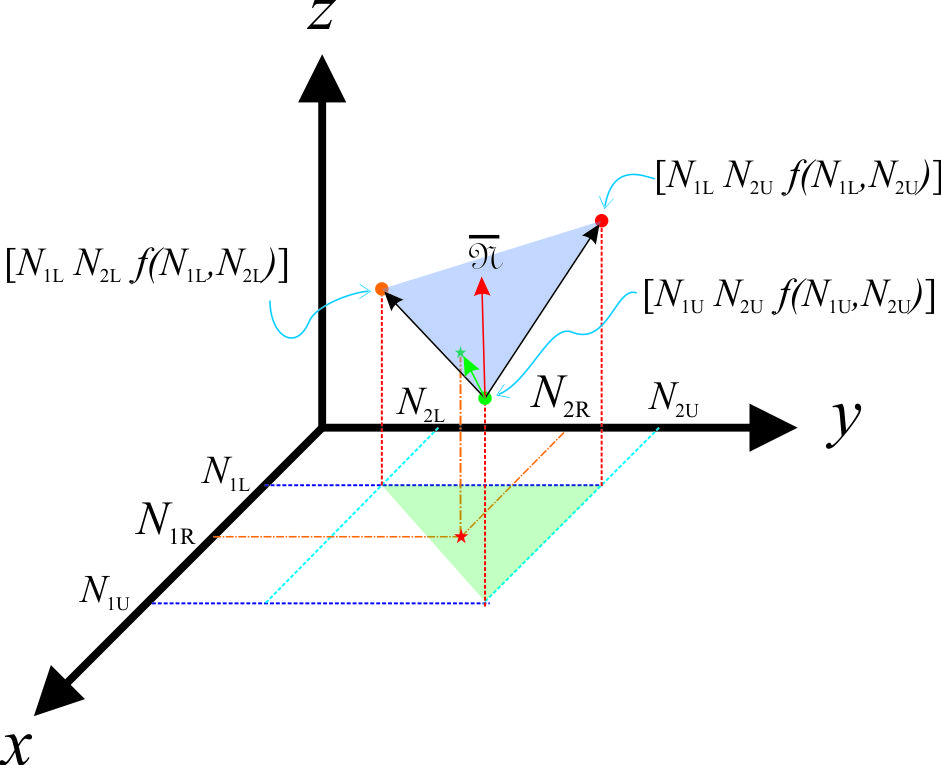
Although the efficiency and energy contribution of renewable energy is rapidly growing, coal is still an important fuel to meet the global energy demand. The integrated gasification combined cycle (IGCC) has high efficiency and minimum cost penalties, compared with conventional coal power plants. Since the operational change of one unit in the integrated IGCC process can influence the other units, techno-economic analysis for performance and cost assessment of the integrated overall process is essential. Furthermore, the techno-economic analysis of IGCC with carbon capture process (CCP) for various types of coal is important because about 53% of global coal reserves are of low rank with various qualities.
In this study, a techno-economic analysis of the entire syngas process including carbon capture unit was conducted for a 500 MW-class IGCC with Shell gasifier using various types of coal. The process simulation of the integrated syngas purification process was performed using Aspen Plus. The performance of Shell gasifier using various coals was simulated using a gPROMS software package.
Firstly, the amount of oxygen and intermediate pressure steam fed to the gasifier were optimized to maximize the cold gas efficiency of Shell gasifier. The parametric analysis of the oxygen to coal feed rate ratio was conducted over the range 0.65~0.85, and the steam to coal feed rate ratio was conducted over the range 0~0.2. Then, the carbon capture efficiency ranged from 80~95% was optimized to minimize the energy consumption of the syngas purification process with a CCP. Finally, to using optimized conditions of gasifier and CCP, a comparative performance evaluation of four difference coals was conducted for the overall IGCC process. And the estimated cost of electricity (COE) considering CO2 T&S cost and coal price was compared among the IGCC processes using four coals (two bituminous coals and two sub-bituminous coals).
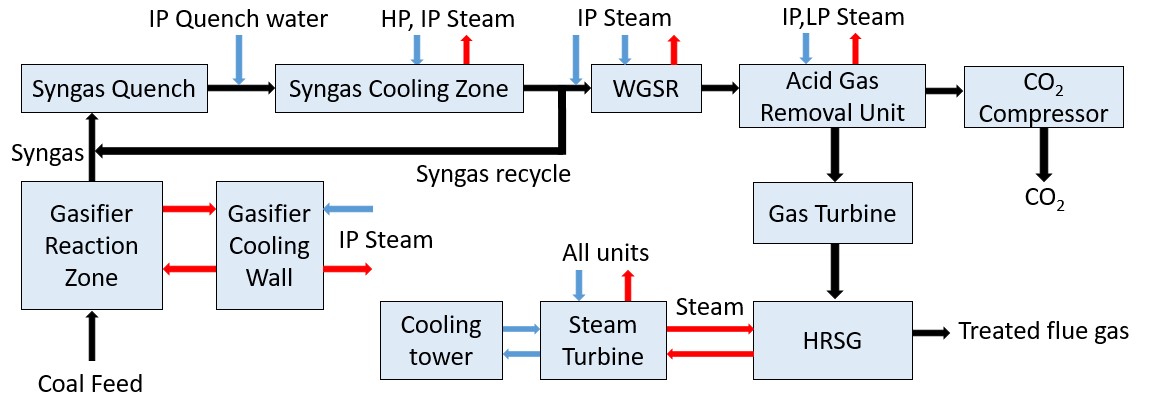
Sterile drug products, represented by injectables of biopharmaceuticals, are manufactured in batch processes by filling drug solution into vials/syringes. Decontamination is responsible for establishing the proper environment for filling, which is typically performed by injecting hydrogen peroxide (H2O2) into the environment such as isolators or clean rooms. Manufacturing of sterile drug products requires changeover processes such as decontamination and cleaning which are time intensive. However, a model can deal with scheduling considering the process design of decontamination is not established.
In this work, we present a model for designing simultaneously decontamination processes and scheduling of filling. The model was developed by incorporating two sub-models: decontamination process model and scheduling model. We defined sterility assurance level of products and the duration required for finishing all batches to be produced as objective functions. Requirements for calculating these two functions are batch information (i.e., the number of batches, batch size, oxidation resistance of product etc.) and decontamination condition (i.e., injection rate of H2O2, relative humidity etc.).
The model was applied to the design case which is 10 batch production of three different sets of products. The calculation result revealed that batch information, especially production size and oxidation resistance of product, is critical to the process duration. At most, 18.1% of the duration can be saved by changing decontamination condition and production schedule. In future, more rigorous simultaneous optimization of decontamination processes and scheduling will be performed. We will also develop a design framework for decontamination processes by incorporating the scheduling model.
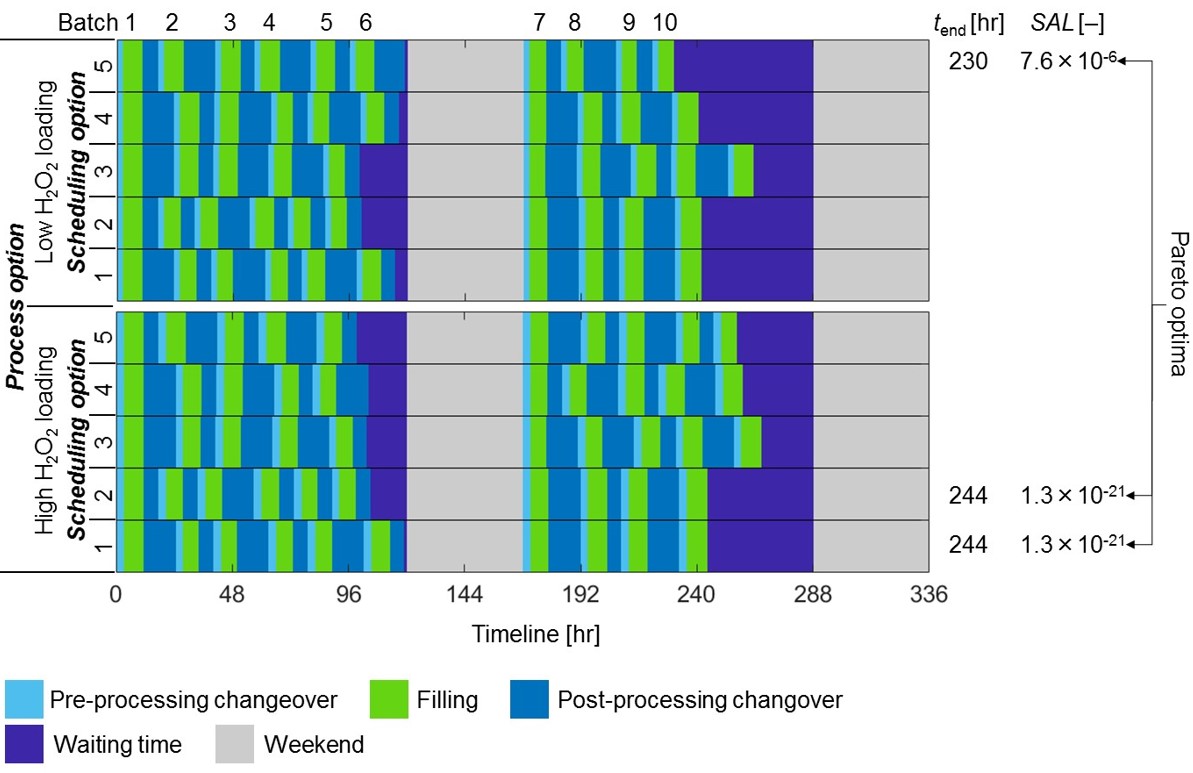
Water integration in batch processes has gained increased attention recently[1-2]. Both freshwater usage and wastewater discharge can be reduced obviously when regeneration reuse is adopted in the design of multi-contaminant water-using networks (WUNs)[3]. It is usually a hard work to design the WUNs involving regeneration reuse, and becomes even worse when batch processes are considered. The paper presents a simple and systematical design approach to manually generate batch water-using networks with multiple contaminants and regeneration reuse. It is assumed that the network runs in cyclic mode and the regeneration unit in continuous mode. The design objectives are to minimize the freshwater usage and wastewater discharge, regeneration flowrate and the costs of storage tanks. The proposed design approach consists of two stages: the batch WUNs are firstly treated as a continuously ones. The concepts of concentration potentials and a modified iterative method are adopted to determine the concentration for regeneration and guide the network design[3] on the first stage. Then, heuristics rules are proposed to guide the design of intermediate storage tanks under the assumption that wastewater can be reused between adjacent batches. The effectiveness of the proposed method is illustrated by two examples from literatures, as good as or even better networks can be obtained.
[1] Li A.; Liu C.; Liu Z. A heuristic design method for batch water-using networks of multiple contaminants with regeneration unit, Chinese J. Chem. Eng. 2019, https://doi.org/10.1016/j.cjche.2018.10.018.
[2] Li, B.H; Liang, Y.-K.; Chang, C.-T. Manual design strategies for multi-contaminant water-using networks in batch processes. Ind. Eng. Chem. Res., 2013, 52(5):1970–1981
[3] Pan C.; Shi J.; Liu Z.Y. An iterative method for design of water-using networks with regeneration recycling. AIChE J. 2012, 58(2):456-465.
Chromolaena odorata L. (C. odorata) with several common names i.e. Siam weed, Bitter bush, Christmas bush, Devil weed, and Camphor grass, is a weed that found in tropical continents. Leaves, roots and flowers of C. odorata have been used as medicinal plants for centuries. Preliminary phytochemical screening showed the chemical composition of C. odorata extracts having phenolic compounds such as flavonoids, saponins, tannins and steroids. The total phenolic compounds (TPC) in medicinal plants are largely acknowledged as biochemical activities such as anti-inflammatory, antiviral, antimicrobial, anti-mutagenic, anti carcinogenic and especially antioxidant agents. This work is interested in antioxidant and antimicrobial activity of an ethanolic extract of C. Odorata leaves. Though, it is found that many solvents can be used to extract TPC from plants. Ethanol with ultrasound assisted extraction was selected. The response surface methodology coupled with the nonlinear solver were used to find the optimal extraction variables. The Central Composite Design (CCD) was employed as the sampling technique. Three studied variables are the ratio of ethanol to the dried leaves of C. odorata (X1), aqueous ethanol concentration (X2), and the extraction time (X3). The extraction conditions were fixed at 40 kHz and 60 °C. It is found that the maximum yield of TPC was 96.49 mg GAE/g dry extract at 57 % v/v of aqueous ethanol concentration, 43 mL of solvent/g of dried sample and 35 minutes extraction time. The relationship between yield and variables is shown below with the prediction error of 13%:
Yield of TPC = 32.9036 – 8.3032 X1 + 6.4377 X2 – 8.7779 X3 + 8.5326 X22
Nowadays, demand of natural dye has increased due to harmful effects of waste from synthetic dyeing to environment and living organisms in water resources. Some synthetic dyes might cause in skin irritation. Natural dye is therefore coming to a better choice for natural fabric dyeing. Teak or Tectona grandis is a tropical hardwood tree. Its weather resistance and beautiful surface made teak as a valuable wood for outdoor furniture and house construction. Moreover, teak leaves are used in food and vegetable wrapping in rural area and some might fall down and waste them as fertilizer for soil. One of the methods to extract natural dyes from teak leaves is ultrasonic assisted extraction (UAE). The yield of natural dye obtained from this method depends on type of solvents and extraction conditions. This research studied optimization of ultrasonic assisted extraction of natural dye from teak leaves. The response surface methodology coupled with the nonlinear solver was employed to find the maximum yield of natural dye. The response surface methodology gives the model represented relationship between extraction parameters and the natural dye yield. Then, the nonlinear solver was used to solve the model for the maximum yield of natural dye. Two different solvents used in extraction, which are water and ethanol, were studied. For each and mixed solvents, the considered parameters in the optimization were frequency of ultrasound (x1), ratio of solvent volume to dried leaves (x2), extraction temperature (x3), and extraction time (x4). The model represented relationship between extraction parameters and the natural dye yield was obtained for each and mixed solvents. The optimal values of extraction parameters were successfully obtained for both solvent conditions.
This research presents a comparative life cycle assessment (LCA) of three photoluminescent types of organic light emitting diodes (OLED): fluorescent, phosphorescent, and thermally activated delayed fluorescent devices (TADF). OLED is garnering attention as a next generation display technology with high luminance, high resolution, and low power consumption. However, general OLED displays employ fluorescent materials with 25% luminous efficacy or phosphorescent materials with 100% theoretical luminous efficacy containing scarce metals such as iridium. Recent developments have discovered new materials exhibiting 100% luminous efficacy without scarce metal, called TADF materials. To analyze the environmental advantage of this new material development, we comparatively assessed lifecycle greenhouse gas emissions (GHG) of three types of OLED employing distinct materials: fluorescent, phosphorescent containing iridium, and TADF. The functional unit of this LCA is provision of one OLED television display. The system boundary considered raw material extraction to the use phase. The lifecycle inventory of fluorescent materials referred to past studies, and that of phosphorescent and TADF were constructed from patents and publications. Energy demand for the material synthesis and OLED fabrication was estimated from lab scale data to manufacturing scale using the authors' a scale up methodology. As a result, the GHG of the TADF and phosphorescent material synthesis were 4-60 times greater than that of the fluorescent material. The major GHG contributor in these materials were the solvent use. Additionally, there was little difference among the lifecycle GHG of OLED displays employing three materials. Because the amount of emissive materials in an OLED display is in the order of 1 mg, the high energy demand of TADF and phosphorescent materials contributed little to the overall GHG of one display. This study sorely analyzed GHG, but further analysis should consider material criticality, which TADF materials shows advantage over other materials.
Absorption column is one of the key equipment for the production of nitric acid, which needs to facilitate both low emission of nitrogen oxides and high concentration of nitric acid product. Based on this, multi-objective optimization of the absorption operation through a framework integrating evolution algorithm and process simulation was conducted, with cooling water usage, reaction pressure, reactant feed & recovery position, mass flow of the middle reflux as key variables. Firstly, Radfrac module of Aspen Plus software was used to model the working process of absorption column, the predicted results of which are in good agreement with the real data collected from a local plant. Then, on the MATLAB platform, the interface program linking NSGA-II algorithm with Aspen Plus simulation was made. Hybrid coding was applied in the evolution algorithm, using real number and integer coding for different types of variables. Finally, simulation process with a population size of 100 and a terminating generation of 30, was performed. The calculation results show that the proposed method can be utilized to obtain a Pareto optimal solution set with uniform distribution. When the concentration of nitric acid is greater than 62.8%, the content of nitrogen oxides increases rapidly with the increase of concentration. Otherwise, the content of nitrogen oxides remains almost unchanged at about 10ppm. Compared with the actual operating condition, the concentration of NOx in the exhaust gas can be reduced by 70ppm while increasing acid concentration by 2%,and the industrial water consumption can be saved by 1200kg/h when adopting optimum settings.
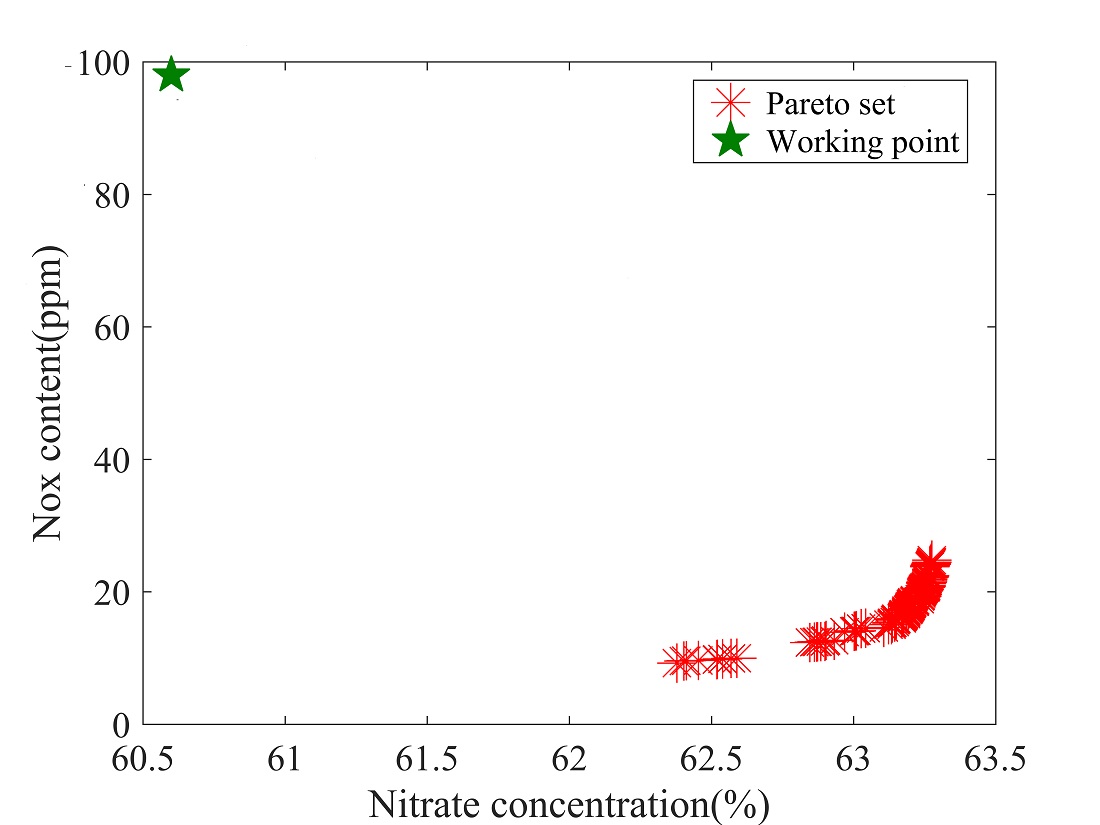
In batch plants, as process equipment are shared by different tasks to produce different products, they use freshwater for equipment cleaning. Also, some tasks require external utilities to meet heating and cooling demands. Now a days, due to stringent environment regulations and increasing cost of effluent treatment and energy, industries are motivated towards water and energy savings. The proposed mathematical formulation deals with wastewater minimization and minimum utility consumption along with the optimum production schedule. For production scheduling, a recent unit specific event based model of Vooradi and Shaik [1] has been adapted and water allocation network (WAN) has been accomplished by considering water reuse opportunities between washing units. Heat exchanger network (HEN) has been modeled by aligning the heat producing and heat consuming tasks in a common time of interval. The model is validated on a case study, from Seid & Majozi [2], comprises of five processing units. The reaction tasks occurring in units U1, U2 and U3 require cooling while tasks in units U4 and U5 require heating. The resulting Gantt chart is shown in Fig. 1 for the optimum production schedule including WAN and HEN. The objective value for total profit is $4809.76, which is comparable to the reported value from the literature.
References
[1] R. Vooradi; M.A. Shaik, Improved three-index unit-specific event-based model for short-term scheduling of batch plants. Comp. Chem. Eng., vol. 43, pp. 148-172, 2012.
[2] E. R. Seid; T. Majozi, Optimization of energy and water use in multipurpose batch plants using an improved mathematical formulation, Chem. Eng. Sci., vol. 111, pp. 335–349, 2014.
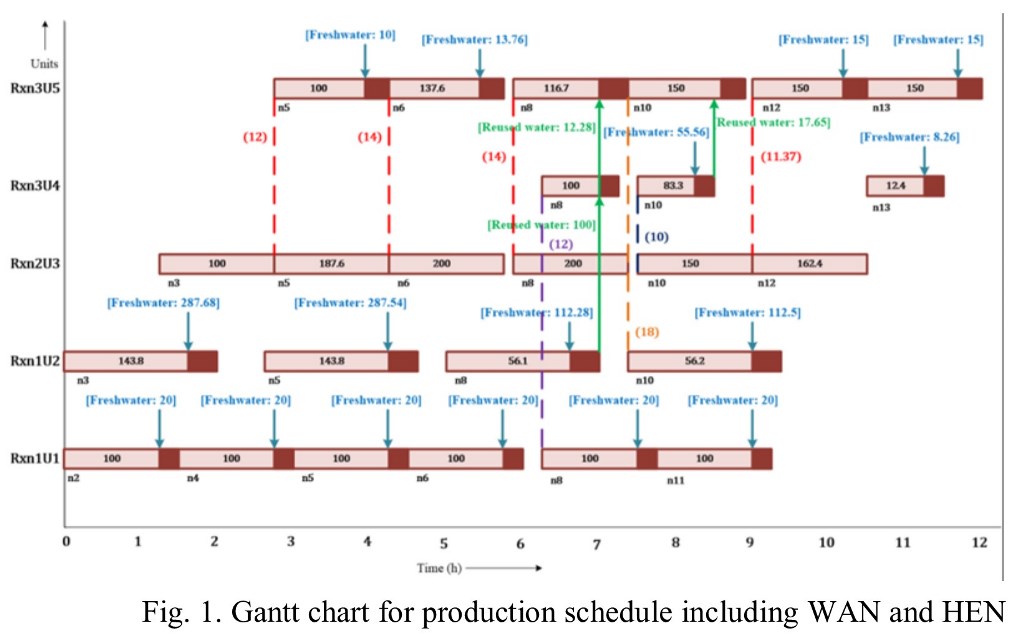
In many developing counties, processing manufacturing (i.e. chemical processing plant, manufacturing facilities, etc) plays an important role in contributing to the country's economic. With the cross-border trading, industrialists are further challenged with global monetary policies, government regulations, resources availability and environmental challenges. The United Nations has initiated the Sustainable Development Goal to encourage the industrialist moving forward to sustainable processing and manufacturing. Despite the Sustainable Development Goal initiatives are encouraging, the industrialists are facing challenges in achieving it. There is a lack of industry expert within the organisation to implement process improvement strategy effectively. The application of lean and green approach has shown positive result in many organisations (e.g. Toyota, Boeing, etc). The lean and green approach is able to reduce the non-value-added product from both operation and environmental perspective. However, the lack of experience personal has delayed the effect of lean and green approach. A systematic framework of lean and green approach should be developed to close the sustainability gap in the processing facility. By doing so, a lean and green index will be used as a benchmarking tool to allow the industrialist to monitor the progressive performance. By including the industry expert and practitioners' input in the framework, analytic network process method will be used together with an adaptive approach. The adaptive approach leverages on the back-propagation method that enables the framework evaluates continuous improvement with time step. The lean and green framework is expected to guide the industrialist for continuous improvement. An industry case study will be used to demonstrate the practicality of the lean and green framework.
Energy transition to renewable-based energy systems with adequate energy carriers such as hydrogen is needed for sustainability. The implementation effects such as greenhouse gas emission reduction largely depend on the specific characteristics in regions. The technologies would not always be implemented in the regions with preferable effects because socioeconomic drivers are needed for the diffusion of the technologies. The driving forces in regions are affected by the region-specific resources, such as financial and human resources in the local governments and firms. In terms of both implementation effects and socioeconomic drivers, the regional suitability for implementing technologies related to energy carriers should be explored for effective policy making and investment decision making. In this study, the regional suitability is explored from two analyses in Japan. Firstly, a region-specific analysis was performed to assess the implementation effects based on the simulation of energy systems. It quantitatively presented the influence of region-specific characteristics, such as energy demands sizes, energy use patterns, and existing structure of energy supply, on the environmental impacts of the technology implementation. Secondly, a factor-specific analysis was carried out by mapping regions based on three factors on implementation, i.e., environmental effects, socioeconomic driving forces, and potential scales. The analysis offers material for discussion on the regions which have preferable implementation effects and can proceed with implementation and on major drivers in the regions. Co-working process inside regions was further generated to explore suitable regions for technology implementation. Through the process, regional suitability, such as actor-network and actors' attitudes toward adopting new technologies and changing the regional systems, which cannot be assessed quantitatively, would be examined and grown. The analysis results can be also used in the co-working process to know prospective regions and actors, motivate actors, and share visions among actors.
Product designers generally prioritize functionality enhancement to meet design demands from the stakeholders in a product life cycle, which affects diverse aspects, e.g., the environment and our society. From an environmental perspective, functionality enhancement tends to cause additional environmental impacts. From a social perspective, the enhancement does not always satisfy the users' satisfaction. Ideally, the designers should be aware of such design consequences of functionality enhancement on the entire life cycle when designing products for sustainability. However, it is difficult for the designers to grasp the design consequences because the consequences are diverse. Therefore, a method is needed to grasp the effects of the functionality enhancement on various aspects in the product design stage.
This study aims to develop an activity model for multi-functional product design for sustainability based on a function-based assessment. To support product design for sustainability, we introduced function-based assessment methods to present the effects of the functionality enhancement on a specific aspect. The methods quantify the changes in the environmental impacts and consumer satisfaction caused by the functionality enhancement based on the linkage of product functions and design variables. To show the roles of our function-based assessment methods in the product design stage, we developed an activity model for supporting multi-functional product design for sustainability.
We performed several case studies, e.g., food packaging, and umbrella, to confirm the applicability of our methods. In the umbrella case, two designs were compared: redesign of the size from small to medium, and that from small to large. Both designs satisfied consumers at the same level, whereas the latter redesign had larger environmental impacts than the former redesign. The result determined the former design to be adopted from environmental and social perspectives. Case studies indicated that the function-based assessment methods could assist the designers in deciding for sustainability.
The modern process industry is required to provide high-grade products with higher yield and low production costs. However, defects are always occurring due to variations during manufacturing process. Thus, it is crucial to predict the occurrence of defects in real time. However, regression methods such as multiple linear regression (MLE) and partial least squares (PLS) are not adequate to describe the defect count data, because they assume that the number of defects (response variable) follows a normal distribution and may yield negative estimates. When the response variable is binary or count data, generalized linear model (GLM) is widely used. GLM assumes that the predictor variables and the response variable have a linear relationship through a link function. Hence, GLM can cope with binary or count data but cannot cope with strong nonlinearity and multicollinearity. Partial least squares generalized linear regression (PLS-GLR) was proposed to overcome multicollinearity, and local likelihood estimation (LLE) was proposed to overcome nonlinearity. However, these GLM-based methods cannot cope with a complex system which has multicollinearity and nonlinearity at the same time. In this research, we developed partial least squares local likelihood estimation (PLS-LLE) to cope with both nonlinearity and multicollinearity by constructing a local PLS-GLR model each time when a predicted value of the response variable is required. The effectiveness of PLS-LLE was validated through a numerical example, in which the predictor variables have a linear relationship, the predictor and response variables have a nonlinear relationship, and the response variable follows a Poisson distribution. Root mean squared error (RMSE) and R-squared (R2) coefficient of determination were used as evaluation indices. Fig. 1 shows the result of repeating this simulation 50 times. It was confirmed that PLS-LLE showed higher prediction accuracy than the existing methods.
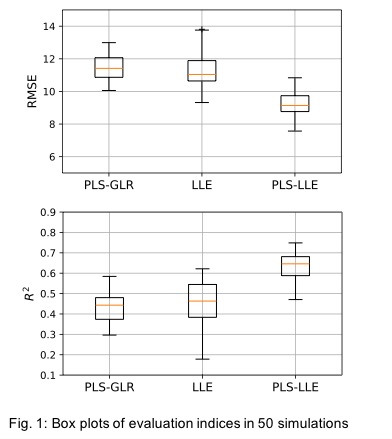
Batch or semi-batch reactors are frequently utilized for industrial-scale chemical production. Online estimation of product qualities is important for controlling the reactors. For example, if we can estimate the concentration of a product with high accuracy, termination of reaction or modification of reaction conditions can be determined accordingly. It is, nevertheless, difficult to sample products online due to extreme such reaction conditions as high temperature and pressure. Even if sampling is possible, analyzing the samples takes some time, making online estimation difficult.
In this study, we propose a scheme for building data-driven or soft-sensor models for solving this issue. Our goal is to time-series predict a product quality (objective variable) from online monitored process variables by a soft-sensor model with high accuracy. The soft sensor model can be built on the process variable data and a product quality data, which is usually measured a few data per batch, i.e. final product quality. Therefore, constructing robust models as well as identification of the Domain of Applicability (AD) is crucial for time-series prediction. Process variable values far from those of final products must be handled property.
Our proposed scheme consists of two methods: in order to make the AD of a soft-sensor model wider, artificial samples with pseudo objective variable values are generated (1). Confidence of each predicted value can be represented by variance of the value using Gaussian Process (GP) (2).
As a case study, we conducted time-series prediction of Melt Flow Rate (MFR) of a semi-batch process plant by using a soft-sensor model. Predictability of the proposed scheme was evaluated by comparing modeling methods, whether or not incorporation of pseudo data. As a result, the error in the high MFR region where the density of data points was scarce was greatly reduced, and predictive ability improved at the same time.
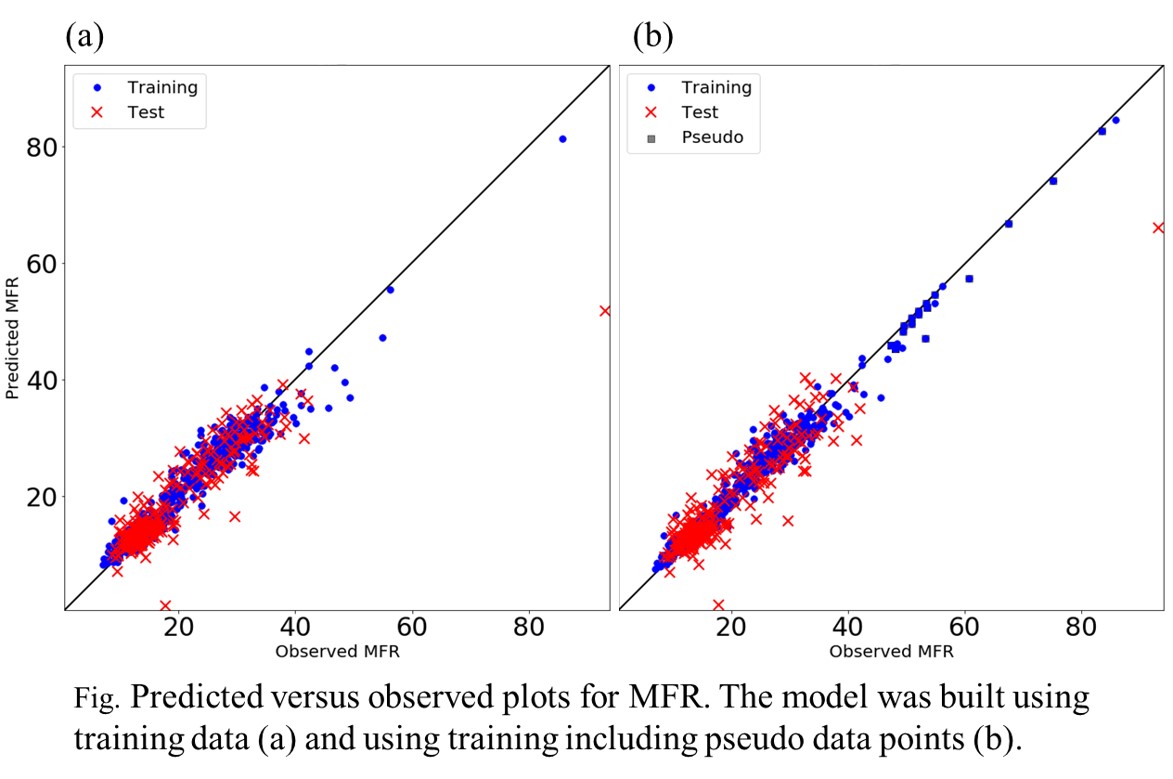
Utilizing hydrogen as an energy carrier is one of important technologies in order to make effective use of renewable energy. The use of hydrogen carriers is expected to transport and store hydrogen in a long-term and stable manner. At Fukushima Renewable Energy Institute, AIST (FREA), research is being conducted to use organic hydride (methylcyclohexane) as a hydrogen energy carrier. Since renewable energy such as solar power generation and wind power generation involves short- and long-term fluctuations, methods to suppress fluctuations of electric power with a battery and hydrogen flow rate by a buffer tank are required. From the viewpoint of cost, however, it is important to reduce the amount of such additional equipment. Therefore, in this study, we examined methylcyclohexane production by a fixed-bed catalytic reactor using hydrogen generated by alkaline water electrolysis with renewable electricity. A control method to supply toluene depending on input electric power to the electrolyzer was developed based on the data obtained under steady state conditions. The method was applied to a hydrogen energy carrier production system operated by using triangular waveforms and renewable energy waveforms. As a result, hydrogen produced from simulated power of PV panels is effectively stored as methylcyclohexane.
Hexamethylene diisocyanate (HDI) is an important raw material in the polyurethane production. Traditionally, the HDI synthesis route involves extremely toxic phosgene as an industrial scale reagent. Recently, thermal decomposition of hexamethylene-1,6-dicarbamate (HDC) has been considered as the most attractive non-phosgene process for the HDI synthesis because HDC can be synthesized by the reaction of 1,6-hexanediamine and the green reagent dimethyl carbonate (DMC). Therefore, synthesis of the intermediate HDC is crucial to the whole process and receives much attention. In this study, three strategies are proposed to design the separation processes in HDC synthesis. Reaction products are fed into a series of distillation columns for separation. These design strategies fall into two categories. Strategies 1 and 2 belong to the first category where DMC and MeOH, which can form a minimum-boiling homogeneous azeotrope, are almost entirely withdrawn from the first column top. Strategy 3 belongs to the second category where some amount of DMC is specially obtained from the first column bottom. Excess reactant ratio of DMC to HDA is adopted between 4 and 8 as suggested from literatures. External heat integration and internal heat integration are utilized to decrease energy consumption. Simulation results show that the processes designed by strategy 3 require the least total annual cost and much economic benefit is achieved through internal and external heat integrations under different excess reactant ratios. The key cost saving from internal heat integration is attributed to the full utilization of DMC-methanol azeotrope characteristic at high pressure, and the higher overhead temperature allowing condenser duty to be released to column bottom.
Palm kernel shell (PKS) is one of the byproducts generated from palm oil mills when fresh fruit bunches are converted into crude palm oil (CPO). Due to the increased production of CPO, PKS increased proportionally. PKS is currently used as fuel source in biomass boilers for heat and power generation. Malaysia, world's second largest producer of palm oil, generates significant amount of PKS annually. For 2018, about 6 million tons of PKS was produced in Malaysia. In view of this, Japanese companies have shown increased interest to utilize PKS as a fuel source to reduce carbon dioxide emissions in nation's power generation industry. As a result, large amounts of PKS have been exported from Malaysia to Japan for power generation. However, with increasing demand on PKS for power generation, it is imperative to evaluate the inherent vulnerability and sustainability of such supply chain. Currently, no documented information available on actual properties of such biomass for international trading and its supply chains between Malaysia and Japan. In addition, it is important to shape supply chains considering alternative technologies and implementation strategies, such as industrial symbiosis. Therefore, the objective of this study is to understand the feasibility and vulnerability of supply chains consisting of export routes for PKS from Malaysia to biomass-derived power plants in Japan. To achieve the objective, life cycle of the supply chain is evaluated based on carbon dioxide emissions. Cradle-to-grave information on palm oil production in Malaysia and exporting mechanism of PKS to Japan are first gathered. Inventory data are obtained from Malaysian palm oil production processes. For supplementary/missing data, ecoinvent and IDEA databases, as well as published articles on palm oil mill production processes are used. Outcomes of this study will contribute heavily towards important decision-making on optimizing the supply chain of PKS between Malaysia and Japan.
Yeast extract (YE) frequently used for bioprocesses, and the compositions were varied in the dependence of the suppliers. The difference of YE compositions often affect on the cell yields in bioprocesses. We focused on evaluation model by a metabolomics approach using non-targeted analysis and statistical calculation. In this study, it was investigated that a statistical models to predict the growth of Escherichia coli from YE component composition as an experimental model of bioprocess. The components of yeast extract were extracted from media containing varying concentrations of yeast extract and analyzed using gas chromatography-mass spectrometer. The yeast extract was categorized into three clades by principal component analysis (PCA). The E. coli growth using yeast extract showed approximately 30% difference at equivalent amount of supplementation. The bacterial growth in the media was estimated for the component profiles by partial least squares regression analysis (PLS-R). A predictive model was developed from the relationship between bacterial growth (as subjective attributes) and component profiles (as objective attributes), and correlation coefficients were calculated. Most of the amino acids in the media stimulated growth; however, methionine had negative effect on growth. In a culture validation, Asp, Val, Glu, and Trp stimulated the bacterial growth, but Met inhibited. The other amino acids tested, Ser, Ile, Asp, Lys, Phe, Leu, Thr, and Gly did not show significant effects on the growth. The results indicate that the metabolomics approach can provide useful feedback information to improve the cultivation.
The purpose of this research is to develop a plant factory with high energy efficiency and capable of adding value. Cultivated plants assumed in this paper are spinach. When grown in a low temperature and high humidity environment, these vegetables have added value such as improved sugar content.
In recent years, plant factories have been developed at home and abroad. However, as a problem of plant factories, much energy is consumed for light source and air conditioning to grow plants. This increases plant production costs as compared to outdoor cultivation and facility cultivation in greenhouses. Therefore, in order to reduce the room temperature rise in the plant factory due to the heat generation of the light source, appropriate temperature control is required.
In this paper, in order to investigate the energy saving reduction method of temperature in a plant factory, a facility combining root zone cooling and hanging cultivation is proposed and thermal analysis is performed. Here, in "hanging cultivation", plants are hung upside down, and water containing nutrients is sprayed to the roots for growth. And, the light for growth is emitted from the under.
Plants have been found to grow normally even at high temperatures by cooling the roots. In this study, in order to make the surroundings of the root cool in the plant factory, we analyzed the temperature change of hanging cultivation with and without the aluminum cooling plate. In addition, analysis of spray cultivation was also conducted.
As a result, the plant factory which brought up the plants by hanging cultivation and installed the cooling plate could lower the root zone more effectively. Therefore, it is assumed that this method can reduce the energy consumption of plant factory compared with other methods.
This work aims to enhance the performance of a reactor by optimizing its design parameters. For this, computational fluid dynamics (CFD) was used to analyze a multi-tubular reactor that involves an exothermic reaction. The design parameters such as baffle configuration, layout and diameter of the tubes, flowrates of feeds and coolants were considered to estimate their impacts on turbulent flow in a shell and its consequent impact on the performance of the reactor. Lastly, these parameters were optimized, and its simulation results showed higher conversion and selectivity for the desired reaction.
Acknowledgment:
This work was supported by a research project entitled “Development of Integrated Interactive Model for Subsea and Topside System to Evaluate the Process Design of Offshore Platform” funded by the Ministry of Trade, Republic of Korea (Project no. N10060099).
Due to the shortage of fossil fuel, bioethanol is a potential green fuel considered to be a sustainable alternative to petro-derived gasoline. The availability of environment-friendly and economical fuels is a worldwide priority. The raw material for bioethanol production are corn, sugar cane, wood, and carbon captured from flue gas. Though the raw materials are different, the product purity of ethanol is at most in the range of 5 to 12 mol percent. The high amount of water in the product leads to higher separation energy cost. There are a lot of methods to break azeotrope between ethanol and water. In the present works, most of the studies compare their results with only traditional industrial processes. Also, most studies do not consider dilute feed conditions. In this study, a comparison between some of the common configurations of extractive distillation, azeotropic distillation and membrane distillation with dilute feed conditions is made using Aspen Plus V10 to obtain optimum results. The results shows that in the 10 mol% ethanol-water feed condition, extractive distillation with pre-concentration distillation column can obtain the lowest total annual cost.
Transportation is a major consumer of fossil fuels and a major cause of air pollution. As an alternative fuel to gasoline to reduce greenhouse gas emissions, the development of bioethanol has received great attention. Bioethanol can be produced from saccharide raw materials, starchy raw materials and cellulosic raw materials. The latter, also known as lignocellulose, are one of the most abundant substances on the planet and are therefore considered an important material to be used to replace petrochemicals for sustainable development. In the process of bioethanol production, lignocellulose needs to be pre-treated by chemical or physical methods to degrade its constituents into monosaccharides for fermentation. The use of zinc chloride-containing ionic solution for lignocellulose hydrolysis has the advantages of high yield, short reaction time, no need for pre-treatment, and is a very promising technology. The ionic solution hydrolysis is then followed by distillation and filtration, and the glucose and salt in the hydrolysate are separated by membrane before the subsequent fermentation. This work aims to reduce the capital and operating costs for hydrolysate separation through the synthesis of an optimal membrane network, while maintaining product specifications and recovery ratios, thereby improving the economic viability of the process. A superstructure-based mathematical programming model for the membrane separation system is developed to facilitate its design and optimization, and to determine the required number of membranes, network structure and operating conditions through appropriate objective functions. A case study will be presented to illustrate the proposed approach.
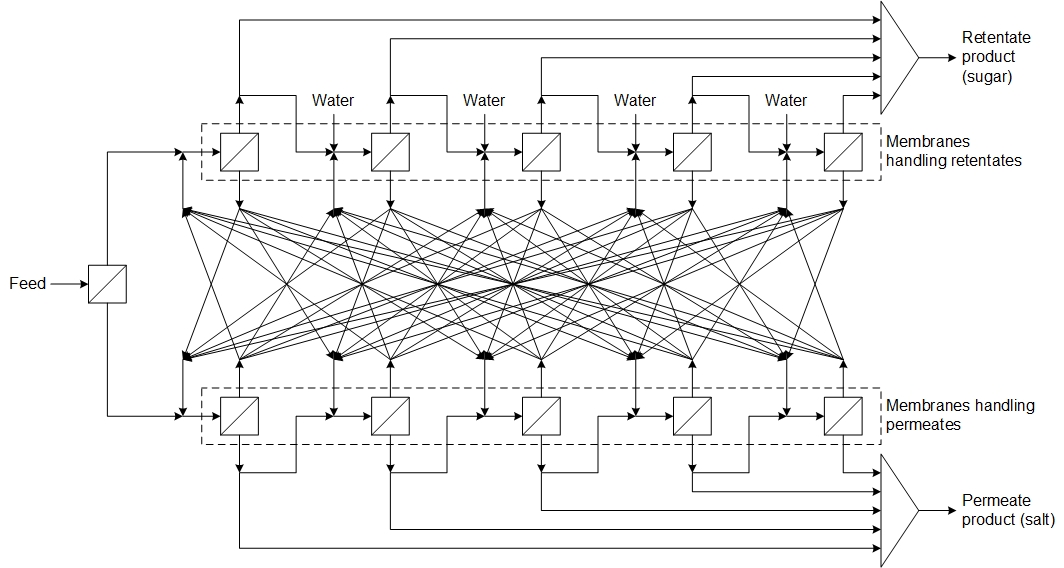
Potable water and energy are gradually insufficient for human needs. To exploit sustainable resources, technologies have been developed to desalinate seawater and produce power using salinity gradient. Reverse osmosis (RO) is one of the major technologies for desalinating seawater, while pressure retarded osmosis (PRO) is a promising technology for power production. The RO desalination plant has the problems of extensive energy consumption and brine discharge, which can be alleviated by hybridizing the RO process with the PRO process as an integrated RO/PRO system. This study is to pursue a higher goal, that is, the power generated by the PRO can provide the energy consumption required for the entire integrated system. Namely, the hybrid system can achieve stand-alone operation (without external energy supply) for seawater desalination. In this study, we conduct feasibility analysis and optimization design for the stand-alone operation of two hybrid membrane osmosis desalination systems (i.e., RO-PRO and PRO-RO systems). Based on the rigorous mathematical model of RO and PRO processes, the feasibility of stand-alone operation is analyzed, and the optimal system design and operating conditions of the hybrid systems are developed through mathematical programming by minimizing the requirement of specific total membrane area. The result shows that the PRO-RO system is a more favorable design structure for a stand-alone hybrid membrane osmosis desalination system. Furthermore, the operation of the membrane osmosis process is bound to be affected by membrane fouling. Based on the membrane fouling model, this study explores the effect of membrane fouling on system energy and water production efficiency, and proposes a dynamic adjustment strategy of operational variables to cope with the fouling effects. The optimal operating strategy is obtained by maximizing the water production while the system maintains stand-alone operation.
Optimum design of the utility system is crucial in offshore platforms that have a restriction in space and weight. The utility system mainly includes production of electrical power and treatment of cooling and heating mediums for the operation facilities in the platform. In this study, the required amounts of electrical power, total heat duty for cooling and heating were analyzed through the operation periods of gas and oil well platforms. In addition, various operation scenarios were included for the analysis. Then, the utility system was designed to meet the requirements of utility consumption. Lastly, numerical model of the utility system was optimized to minimize overall capital and operating costs, having a higher energy efficiency of the platform.
Acknowledgment:
This work was supported by a research project entitled “Development of Integrated Interactive Model for Subsea and Topside System to Evaluate the Process Design of Offshore Platform” funded by the Ministry of Trade, Republic of Korea (Project no. N10060099).
In this study, the isopropyl-acetate (IPAc) production via reactive distillation (RD) process is taken to observe the control performance with the assistant of virtual model. The artificial neural network (ANN) was trained to be the virtual model, and the Aspen Plus Dynamics was considered as the real plant. The inputs of the ANN model contain the feed flowrate of isopropyl alcohol (IPA) (FIPA), the setpoints of the temperature controllers (TC12SP, TC3SP ), and the feed composition of IPA and acetate acid (HAc) (XIPA,F, XHAc,F). Then, the corresponding outputs are the IPAc and water mole fraction in the products (XIPAc, XWater).
In reality, the catalyst activity would become smaller with time. However, the virtual model would not have the aging phenomenon if the model is built under the steady-state. At length, the model mismatches between model and process would become greater if the virtual model does not be adjusted. To this end, this study focused on the updating method for the models which are established under the steady condition .In order to maintain the product purity, the model predictive control (MPC) was utilized to control the product concentration.
The method of updating model is designed as once per day and an adaptive filter would be added. Based on the measurements, the weights and biases of the adaptive filter would be modified by least mean square (LMS) algorithm. According to the results, the on-spec products could be generated for 6 months if the model had been updated. Otherwise, the off-spec products would start to be produced after 4 months if the model were not updated.
Reference:
Lee, H. Y., Li, S. Y., Chen, C. L. Evolutional Design and Control of the Equilibrium-Limited Ethyl Acetate Process via Reactive Distillation-Pervaporation Hybrid Configuration. Ind. Eng. Chem. Res. 2016, 55, 8802-8817.
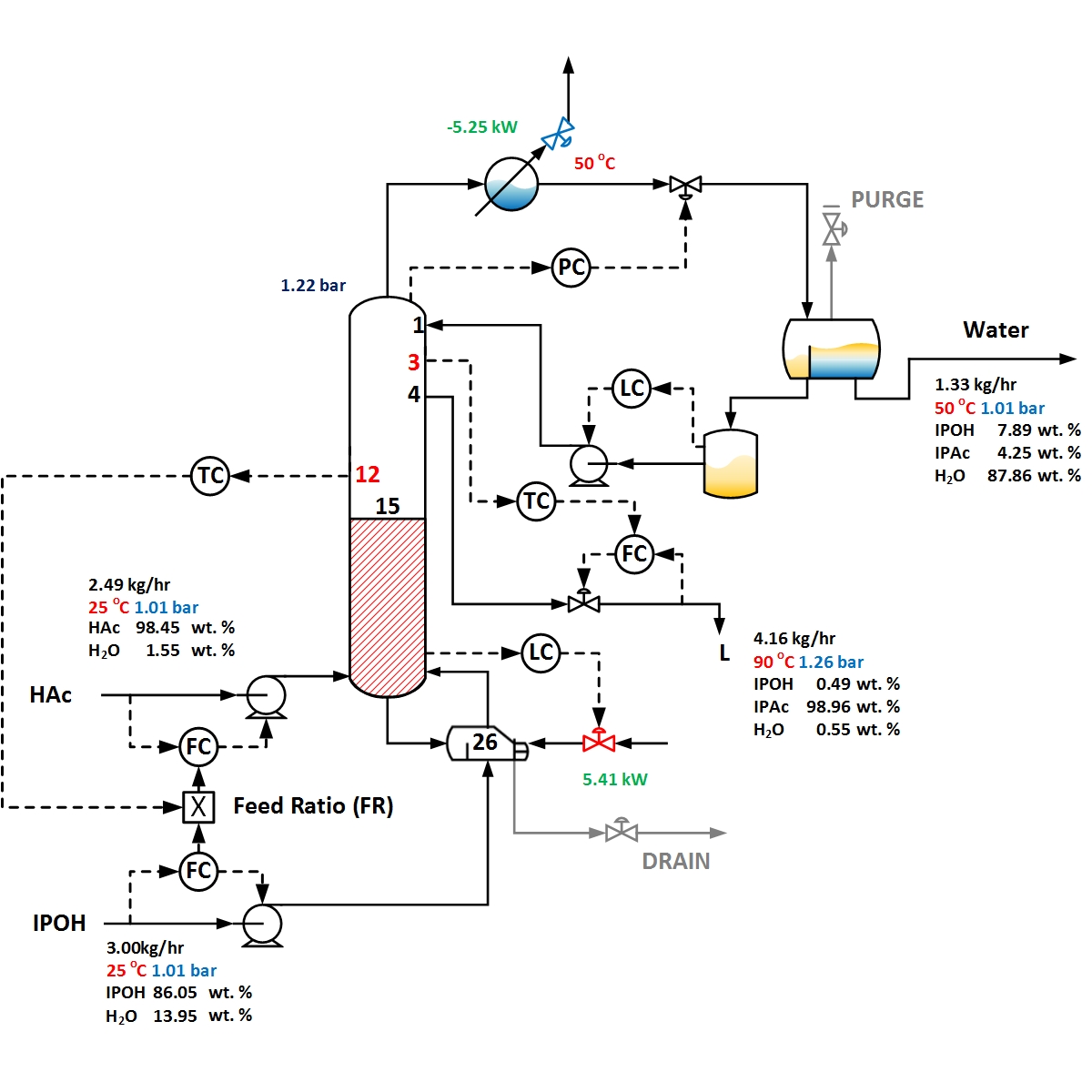
In this study, an internally heat-integrated reactive distillation column (r-HIDiC) is proposed. The silane (SLC) multi-tasking reactive distillation (RD) process is chosen as the case study. The flowsheet of the SLC production process is utilizing two RADFRAC columns from Aspen Plus V10.0 simulator. One column is operated at a high pressure (HP) and another column is in a low pressure (LP). HP column has no reboiler and it is divided into two sections, the rectifying and reactive sections. LP column has no condenser and it has a stripping section. The bottom product from HP column will be sent to the top stage of LP column. The top vapor of LP column will be recycled to the bottom stage of HP column through a compressor. The desired products will be obtained in the top stream of HP column and byproduct will be obtained in the bottom stream of LP column. An iterative optimization procedure is applied to obtain the optimal design that have the minimum total annual cost (TAC). Later on, the multi-tasking reactive non-HIDiC process will be assisted using the optimal results. Then, an internally heat-integration will be implemented in the process (r-HIDiC). The whole reactive section of HP column is a heat source, and the stripping section of LP column acts as a heat sink. Figure 1 shows the flowsheet of SLC multi-tasking single RD (left side) and r-HIDiC (right side) configurations, respectively. The heat required for evaporation in the stripping section is obtained from the reactive section, reducing the heat duty of the reboiler (however work is required for the compressor). From the simulation result, the SLC multi-tasking r-HIDiC configuration can achieve energy saving of up to 15% compared to the SLC multi-tasking single RD configuration.
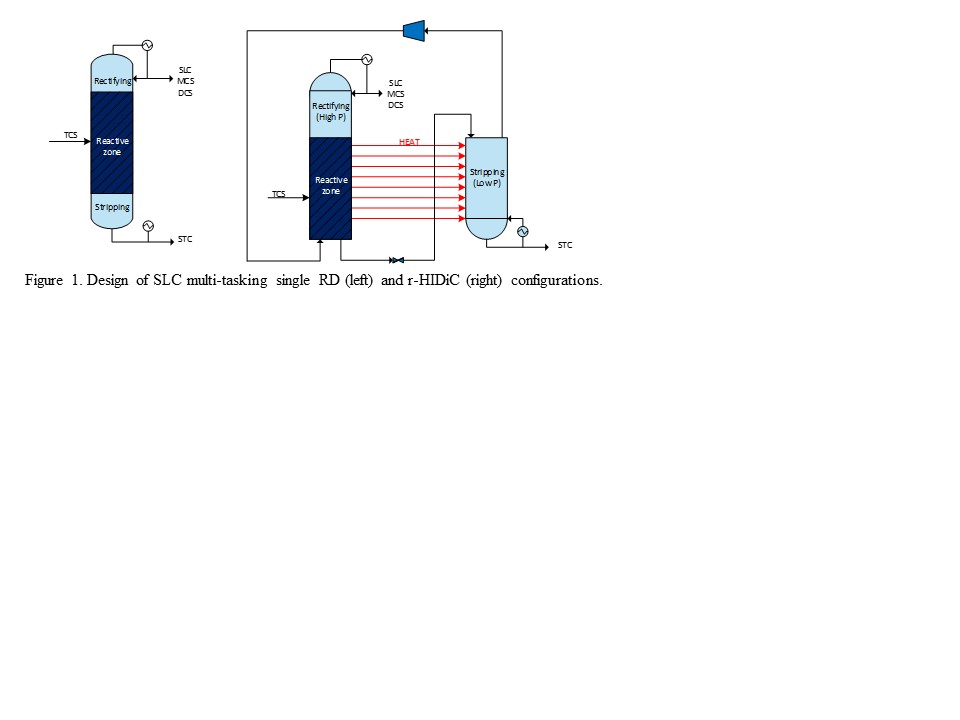
Relative humidity (RH) has shown its importance in almost every field from weather prediction to pharmaceuticals industries. The RH estimation is particularly important to maintain the product quality and to prevent the equipment from corrosion reactions. For RH estimation as a function of dry-bulb temperature and wet-bulb temperature, psychrometric chart is used which is a graphical representation of the physical and thermodynamic properties of the psychrometric processes. Nevertheless, the RH observation from psychrometric chart is not an easy task, mainly due to the high chances of human error. Therefore, the rigorous and user-friendly estimation of RH is an ongoing issue, so far. In this context, we are going to implement the state-of-the-art “Machine learning” technique to develop a simple, robust, and rigorous predictive tool for the estimation of relative humidity. The performance of the proposed machine learning-based predictive tool is validated through the psychrometric chart and also compared with previous published estimation tools. This work was supported by Basic Science Research Program through the National Research Foundation of Korea (NRF) funded by the Ministry of Education (2015R1D1A3A01015621) and by Priority Research Centers Program through the National Research Foundation of Korea (NRF) funded by the Ministry of Education (2014R1A6A1031189).
At present, HPLC / MS is used as a method of discriminating a liquid. This method is a high-precision physical-chemical analysis method that detects a specific mass from chemical components to be separated. However, these analysis methods require expensive equipment, and there is a problem that it is difficult to put them into practical use as a simplified method. Furthermore, in order to understand the chemical composition, pretreatment of the liquid sample is required.
For the above reason, in this research, without using a high-precision analysis device, a tea-based beverage is photographed using the image sensor (the camera of a smartphone), and the type is determined and classified by analyzed the image. After that, we linked the relationship with tea-based beverages and examined the possibility of classification.
In comparison results of histograms of photographed images, it was confirmed that green tea, black tea, and oolong tea can be classified by comparing histogram results indicating Blue brightness, Red brightness, and Green brightness.
Next, the number of peak elements and the peak class for Red and Blue was shown as scatter plots. As a result, according to the number of peak elements, it was confirmed that the variation was large in any sample and the classification was difficult. On the other, in the peak class, it was shown for each type of sample, and it was confirmed that it could be classified.
From the above results, it has been confirmed that classification of tea-based beverages is possible easily from images taken using a familiar high-performance image sensor such as a smartphone. In the future, we will deepen examination of methods that can classify samples more accurately, methods of discriminating unknown samples, and further studies using multivariate analysis.
We have the aim that the new environmentally harmonious industrial process to realize a sustainable society. One of the ideas that is attracting attention in chemical process development is Process Intensification(PI). PI has meant an approach aiming at a drastic improvement in process performance through new connections, high precision and compactness for each of the important components of the process. Structured catalyst would be novel tool for PI as the promotion functions of catalytic reaction, heat transfer, and fluid mixing.
In this study, Micro-Partition (MP, supplied by Nano Cube Japan Co., Ltd.) (Fig.1) was utilized as the structured catalyst. When the MP structured catalyst(MPC) would be filled into the gas-solid catalytic reactor, it is expected that reactivity will be improved because the reactants fluid is disarranged. It was suggested from computational fluid dynamics(CFD) that MPC could change the flow in unidirectional.
In the experiments of the MPCs are stacked in the same direction, it was confirmed that the bottom catalyst didn't effectively contribute to the reaction. The flow could be changed by structure of MP. It was also carried out the experiments that the direction of the MPCs was changed variously for confirming the contributions toward reactivity when designing the reactants flow voluntary. It was achieved the high reactivity when the MPCs were packed like to promote mass transfer by convection. In other words, it is possible to improve the reactivity by to finely control the fluid and to design the mass transfer in the catalytic reactor by using the structured catalyst.
Furthermore, it was observed what occurring about relationship between mass and heat transport and chemical reaction around the catalyst was analyzed in detail utilizing simulation software COMSOL Multiphysics. And it was proposed MPC packing method to maximize the reactivity based on the simulation results.
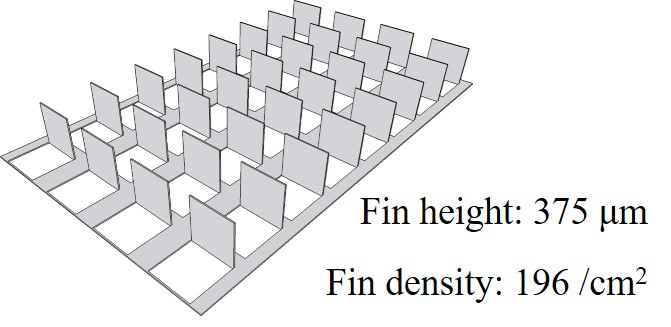
Solvent-based post-combustion carbon capture (PCC) is a mature and essential technology to solve the global warming problem. The high energy consuming issue and the flexible operation required by the power plants inquire the development of effective control systems for PCC plants. This study proposes the optimal-based control approach that utilizes optimal setpoint values for the quality controllers. The five optimal-based control schemes studied all employ L/G (liquid to gas ratio in absorber) as one quality control variable. Performance comparisons with a typical conventional control scheme are conducted employing a rate-based dynamic model for the integrated MEA (monoethanolamine) solvent PCC process developed on Aspen Custom Modeler. Compared to the typical control scheme, the optimal-based control schemes provide faster responses to the disturbance changes from the flue gas conditions and the setpoint change of the CO2 capture efficiency as well as better results in terms of IAEs (integral of absolute errors) of capture efficiency and reboiler heat duty during stabilization period. LG-Tstr and LG-Tabs-Cascade are the best schemes. In addition to L/G, these two schemes employ the control of Tstr (the temperature of a stage of stripper) and a cascade control of Tabs (the temperature of a stage of absorber)(outer loop) and Tstr (inner loop), respectively.
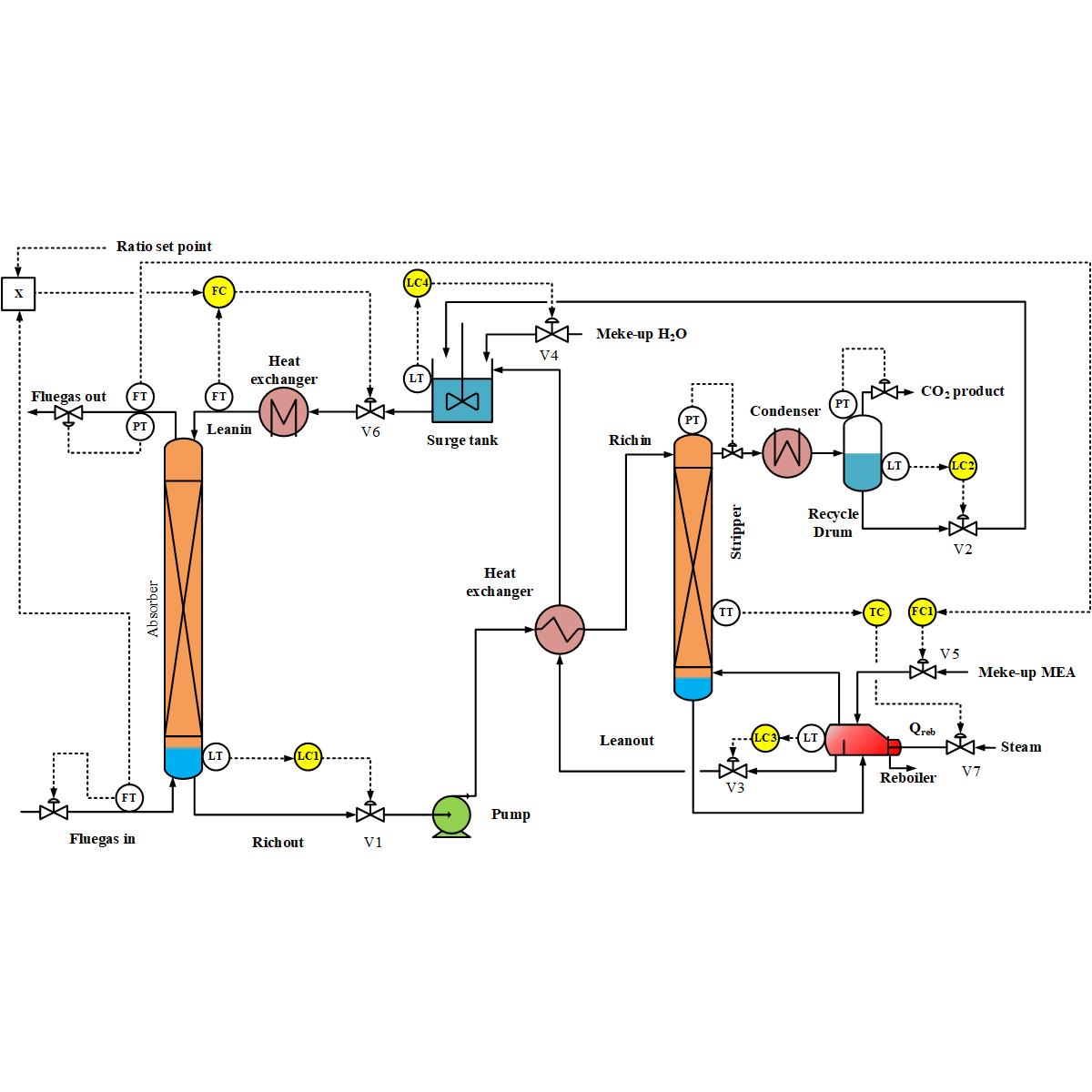
An oscillatory baffled reactor is a continuous tubular reactor with baffles arranged at equal intervals, and oscillatory flow is added to the net flow in a laminar flow region. Vortices are periodically generated in each baffle section, and mixing in the radial direction is promoted while axial dispersion is suppressed. We proposed a micro-scale oscillatory baffled reactor, μOBR, as a new tool for reaction analysis. In this study, the mixing mechanism and axial dispersion were investigated by the flow visualization and the tracer response experiment, respectively. The μOBR is the microchannel on the transparent acrylic resin plate with the size of depth 0.8 mm, width 0.8 mm, baffle width 0.4 mm, baffle distance 1.2 mm. The number of the baffles was 25 along the microchannel. In order to conduct the mixing characteristic experiment, the colored water with Rhodamine B was employed as the tracer. The flowing state in the 10th and 20th baffle spacing section in the channel were visualized by a microscope high-speed camera with the flame rate of 125 fps. The step response, F curve, was obtained from the concentration of Rhodamine B. The fitting of the response profiles with the F curve were carried out to calculate a parameter D/uL representing axial dispersion. The Reynolds number, Ren, was calculated from the net flow rate, and the oscillatory Reynolds number, Reo, was calculated from the frequency and amplitude of the oscillatory flow. The higher Ren gave the higher D/uL. It was difficult to suppress the axial dispersion because the vortices generated at the baffle wall could not grow larger and axial flow passed through the channel directly. On the other hand, the flow visualization showed that the radial mixing was enhanced and better plug flow property was obtained with the Reo increase.
State estimation of chemical processes is an important technology for controlling product quality and efficient operation. Especially, estimating difficult-to-measure values by soft sensor have been attracting attention, because it is faster and cheaper than measuring actual values.
The purpose of this study is to apply the time series data for estimating the product quality of a chemical plant. The authors focused on applying several neural network algorithms, such as Recurrent Neural Network (RNN) which enable utilization of time series data. Various algorithms, such as PCR, PLS and SVR, have been applied, however most of these methods have the disadvantage of not utilizing dynamic characteristics.
As a case study, we used a dataset from the Tennessee Eastman Challenge Process, and the concentration of a component was estimated from 33 explanatory variables. Several representations of time series data were investigated to tackle with the difference between sample intervals of the target variable and explanatory variables. Moreover, we tested various neural network architectures and traditional machine learning algorithms.
As a result, we found the superiority of neural networks compared with other algorithms. Specially, among neural networks, CNN-RNN hybrid model gives excellent results.
This hybrid model achieves much better than the traditional SVR in both R2 and RMSE, and better than the simple LSTM. We also found that it is efficient to use the samples without target data.
The results show that the proposed hybrid model provides an accurate tool to estimate process quality with the help of dynamic feature extraction by the CNN on the proposed data format.
Dealing with the unpredictable performance of a power plant has become one of the most challenging problem faced for all power plant engineers in the world. Engineers have to deal with unplanned maintenance and overhaul of power turbines resulting in a massive profit loss as it is not able to keep up the efficiency to achieve the production demand of electricity in time. To deal with the issue, production scheduling and maintenance planning are often considered and optimised independently in practice especially in power generation industry. However, conflict between production and maintenance scheduling has been an issue in managerial decision due to its interdependency. Hence, in conjunction with the advancement of Industry 4.0, a well-structure production-maintenance schedule modelled with MatLab is proposed to setup a reliable and systematic approach to deal with both maintenance and production problem. On top of that, machine configuration scheme is studied and analysed in this paper to provide an enhancement in stability and accuracy to the scheduling system. With the deployment of a P-Graph model, it provides a visually appealing interface to the users, allowing them to understand the insights of the system's decision-making principle. Optimal solutions are obtained from the model based on the load demand, allowing the system to select the best machine configuration scheme correspond to the objective of the research. This not only aimed to improve the system efficiency, also to maximise the plant profit and minimise any possible time and energy waste. It is believed that the development of the holistic package of smart scheduling smart system can be a promising breakthrough to the industry by improving the reliability, accuracy and availability of modern manufacturing system.
The global warming is serious problem in the world. Therefore, utilizing the renewable energy and low-temperature waste heat is attracted attention. Binary cycle is kind of heat engine and one of the technologies to be used a low-heat energy. Binary cycle is low power generation and thermal efficiency. Hence, improvement in power generation and efficiency are required for this technology. In order to high power generation performance, in this study cascade binary cycle utilizing separation membrane was employed.
Microreaction technology has attracted attention of chemical engineers, because microchannels show high heat and mass transfer rates. Intensification of multiphase processes, such as gas-liquid reactions and extractions, is an important application of microreactors. Slug flow is a typical flow pattern of multiphase flow in microchannels, and widely used in this field. In slug flow, gas and liquid slugs flow alternately, and a high interfacial mass transfer rate is often observed due to an extended surface area and the strong recirculation motion of fluids in each slug. Slug length is an important parameter representing the slug flow, and strongly influences the mass transfer rate, because the specific surface area and the rate of circulation decreases with increasing the slug length. Thus, to keep mass transfer rate high, it is necessary to monitor and control the slug length online. One of the typical approach to the slug length monitoring is to measure the pressure variation in the microchannel, and the periodic change in the pressure is related with the slug length.
The purpose of this research is to develop a technology to measure slug length by using AI technology. Air-water slug flow was generated in a microchannel and the slug length was varied by manipulating the flow rates of both phases. Then, photographs of slug flow with different length were taken. An artificial intelligence was trained to relate the image and the slug length by using the deep learning algorithm. With the trained AI, the slug length was successfully identified from the image of the slug flow.
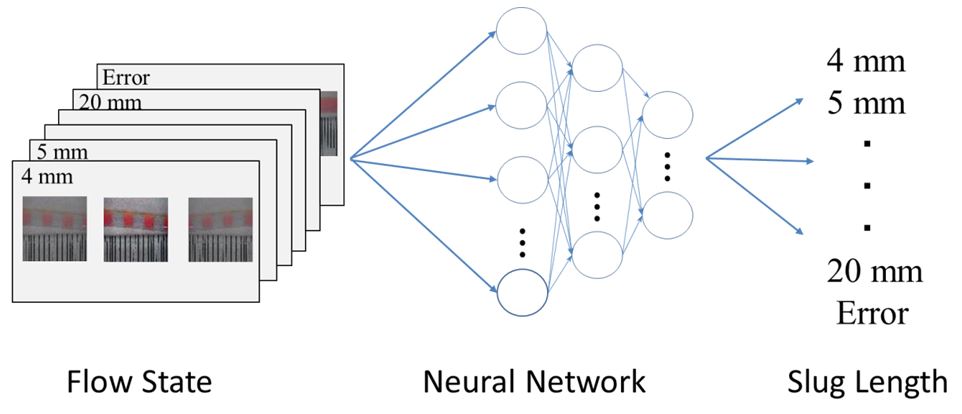
Tissue culture technique has been widely used for pharmaceutical and biomedical applications such as drug development, tissue repair, and even transplantation. However, the tissue culture process is limited due to time-consuming, labor-intensive and risk of contamination. For instance, the development of lung cells into a tissue requires periodic medium change for at least one month, allowing to proliferate and differentiate. Furthermore, standardized medicine produced using the conventional process is not suitable for personalized treatment due to compatibility and efficacy. In this work, we introduced microfluidic technology into the tissue culture process to develop a Plug-and-Play tissue culture platform which can eliminate the risk of contamination and improve the cell culture efficiency. In addition, the culture platform can be operated automatically in specific cell culture processes, such as mucus washing and air-lifting. The Plug-and-Play tissue culture platform includes a tissue card, a fluid control base, peristaltic pumps and pinch type valves controlled by a computer. This tissue card had two independent chambers separated by a microporous membrane to generate liquid-liquid interphase and air-liquid interphase cell culture environment for cell proliferation and differentiation, respectively. The Plug-and-Play culture platform mounted with miniaturized devices can simplify the tissue culture procedure for personalized application. It only requires inserting the tissue card at the beginning and removing it after finishing. The results demonstrated that the human lung cancer cells (A549) and human bronchial epithelial cells (HBEC) can be cultured in both submerged and air-lifted conditions at a dynamic flow condition for long-term cell culture. Taken together, these results conclude that the Plug-and-Play culture platform is capable of applying to diverse and complicated tissue culture procedures with a simple and easy culture process.
In recent years, in the chemical process industry, it has been performed a lot of methods in many design processes using simulation to reduce design costs. In process design of the chemical process industry, operating variables (such as the operating pressure) are determined so as to minimize target variables (eg, equipment cost). By automating this calculation process, which has conventionally been performed manually, the number of simulation steps can be significantly reduced. For that purpose, application of optimization calculation method is useful. In addition, there are multiple target variables in the chemical process industry, rather than one. Additionally, such variables are often in a trade-off relationship with each other (e.g., torque and discharge flow rate of a mixier) For this reason, in process design of the chemical process industry, application of multi-objective optimization is required rather than single-purpose optimization. Therefore, we performed optimization calculation of the mixing process in order to investigate the applicability of the multi-objective optimization method to the design of the mixing process, which is a particularly high demand process in the chemical process industry.
To find a new useful catalyst, many different catalysts must be prepared and the performance must be evaluated. Usually catalyst evaluation is conducted in a laboratory using conventional chemical apparatuses. The performance data should be collected for different temperature, flow rate and feed concentration. Since the experimental procedure is fixed, efficiency of catalyst testing is expected to increase greatly by introducing automated experimental apparatus. There are several commercial products for such purposes, but they are very expensive and thus deposition of solid substance or clogging incurs high repair cost. This study aims at development of a new catalyst evaluation system which can be built at a lower cost, and allows flexible operation. As an example of heterogeneous catalyst reaction, dehydration reaction of ethanol over alumina catalyst was used. Nitrogen gas was used as a carrier gas and the stream was equipped with a mass flow controller. The reactor was a glass tube filled with alumina power, and placed in an electric heater. The reacted gas stream was brought to a 6-way valve, which was used as an injector for a gas-chromatograph. The mass flow controller, electric heater and the 6-way valve were connected to a personal computer. The main control system was built on a Microsoft Excel, which directly send out the signals to control each devices. The spreadsheet software also records the state of the system, such as flow rates and temperature. A system capable of automatically finding the optimum conditions for this device was also incorporated to further improve the efficiency of the device. The developed system was realized at a low cost, since a popular spreadsheet software was used as the platform of the measurement system.
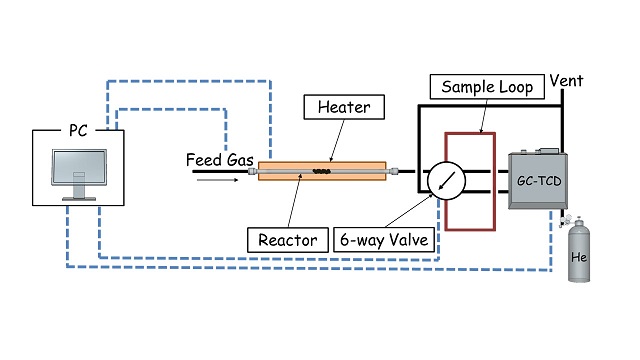
Distillation is a very popular separation technology and one of the drawback is the high energy consumption rate. To improve the energy efficiency, a variety of distillation apparatuses and processes have been proposed to date. Our group has also proposed another new distillation system, which is called Pressure Driven Distillation System (PDDS). This system is different from the conventional distillation in that the mixture is separated under isothermal condition. To gain the driving force for separation, the pressure distribution is formed. Since the system is isothermal, the heat released from the condenser can be used as a heat of evaporation at the reboiler. This thermal configuration of PDDS enables us to reduce the energy consumption rate greatly. In this study, we constructed PDDS and the separation performance was experimentally evaluated. The results showed that the vapor and liquid compositions at each stage were close to the equilibrium values, and that PDDS showed a sufficiently high separation performance.
The experimental apparatus was converted so that it allows flexible change in the configuration. For this, we built the interfaces to sensors and actuators, such as pressure sensors and valves, so that they can act as IoT devices. Through the internet connection, the measurements are sent to a database in a host computer, which can be viewed graphically on a website. It is also possible to control pumps to change the stage pressure by sending commands from the host computer. A program was built on a host computer so that solenoid valve is manipulated in the direction of decreasing the pressure, when an abrupt increase in the rate of pressure change is detected.
